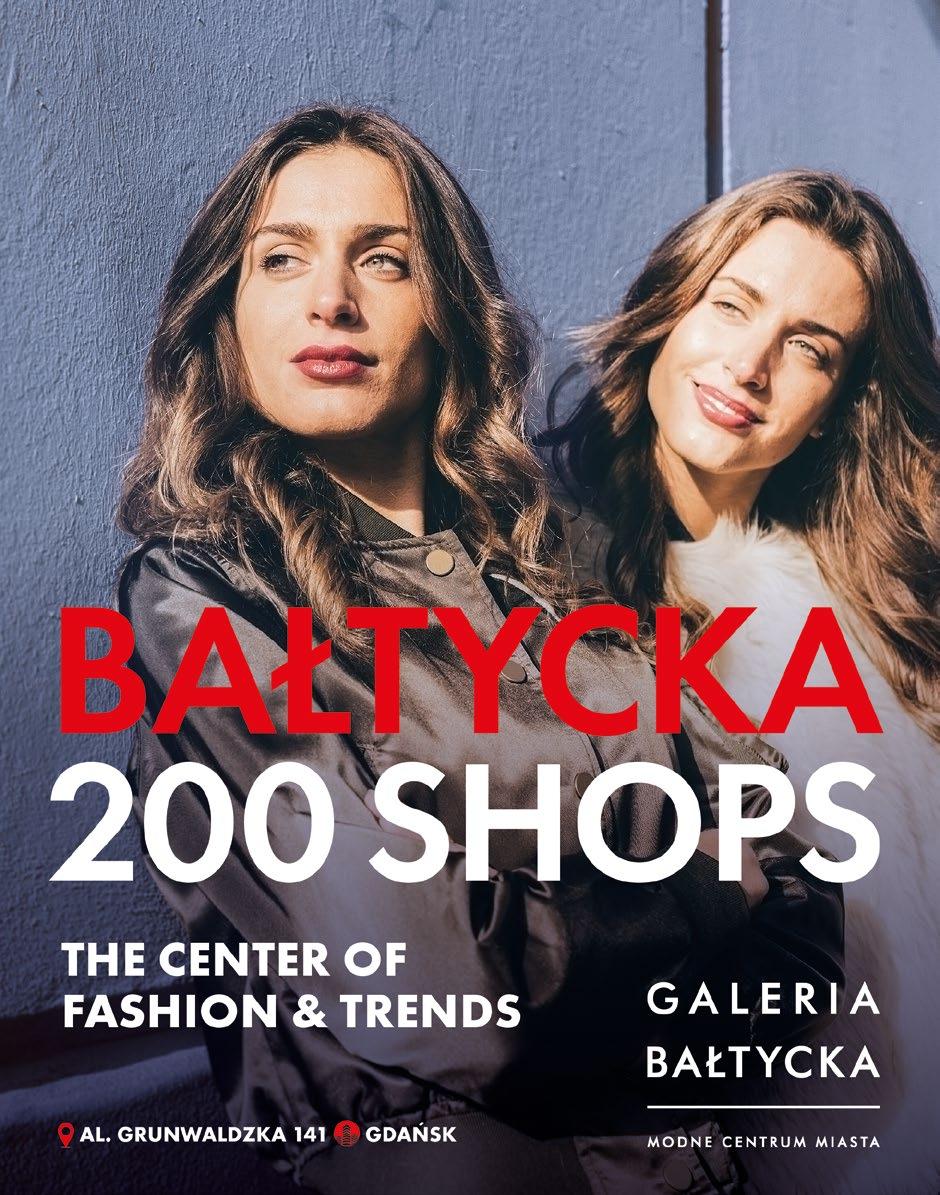

GDAŃSK
Sopot & Gdynia
Walking tours
Local dishes
Transit tips
More!


Gdynia Grabówek
Stena Line
GDYNIA
Gdynia Główna Sopot
Gdynia Wzgórze Sw. Maksymiliana
Gdynia Redłowo
Gdynia Orłowo
Gdynia Karwiny
Sopot Pier
SOPOT
PRZYMORZE
Gdańsk Oliwa
R Ę BIECHOWO
Gdańsk Port Lotniczy
Gdańsk Rębiechowo
Gdańsk Lech Wałęsa Airport
MATARNIA
THE TRI-CITY
Scale 1:190 000 0 2 4 km
Gdynia–Hel(MayOct)
Karlskrona – Gdynia
Sopot–Hel(MaySep t )
BAY OF GDAŃSK
Gdańsk Wrzeszcz
WRZESZCZ
GDAŃSK
Gdańsk Matarnia Gdańsk Śródmieście
Gdańsk Stocznia
Gdańsk Główny
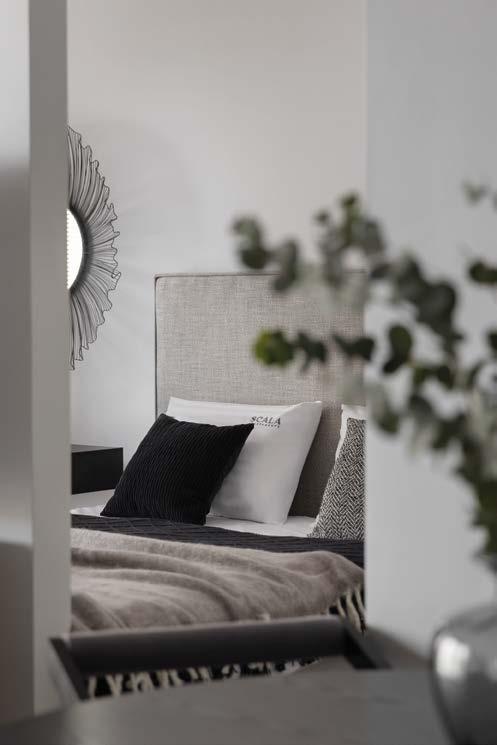
From the Editor
Another highly-publicised election in US, another year of war in Ukraine, and another political scandal in Warsaw making the headlines. Any big news from Gdańsk? Yes! Our local Christmas markets garnering 'Best Christmas Markets in Europe' from the organisation of the same name. Although my colleagues down south are convinced that Wrocław's is better, I wouldn't hear of it! Unfortunately, we didn't mention it in the guide, because we'll be circulating this one until April 2025, but if you're in town before December 23rd 2024, make sure you swing by! As an Australian, European Christmases are still a novelty for me, and, despite my age, I still go out to play when the first snow falls. Truth be told, Gdańsk doesn't get as much snow as in Kraków or Warsaw - overall, a consequence of climate change. However, last year was surprisingly cold and did yield alot of white stuff, so we can hope that it'll still trend that way in early 2025. As a musician, I'm a fan of live music (not to be confused with people pushing play and crossfading between audio sources), and winter essentially gives me no excuses. If you consider yourself likewise, then I encourage you to check out 'Live Music for Cold Ears' on page 17. That's all for now. Enjoy your stay!
PUBLISHER
IYP City Guides Sp. z o.o. Sp.k. Ul. Karmelicka 46/51 31-128 Kraków, Poland
www.iyp.com.pl poland@inyourpocket.com
CIRCULATION
10,000 copies
STAFF
Editor: Pierre Duyker
Sales: Bartek Matyjas (+48) 784 966 824
Marketing: Monika Boguszewska-Stopka (+48) 728 879 494
Research: Karolina Adamik
Design & Layout: Marcin Jakubionek
Maps: Tomáš Haman
COVER IMAGE
Foreground - The tower of the 'Main' Town Hall (p.41); Background - St Mary's Basilica (p.44). Photo by Patryk Kosmider / AdobeStock.
COPYRIGHT NOTICE

Pierre is an Australian living in Gdańsk. He first came to Poland in 2010 and, after several subsequent trips here, chose to settle in the Tri-city area due to its unique history and close proximity to the beach! In his spare time, he enjoys going to concerts and writing music for indie computer games.
All content copyright IYP CIty Guides Sp. z o.o Sp.k and its partners, unless otherwise stated. No part of this publication may be reproduced without written consent from the publisher. The brand name In Your Pocket is used under licence from UAB In Your Pocket.
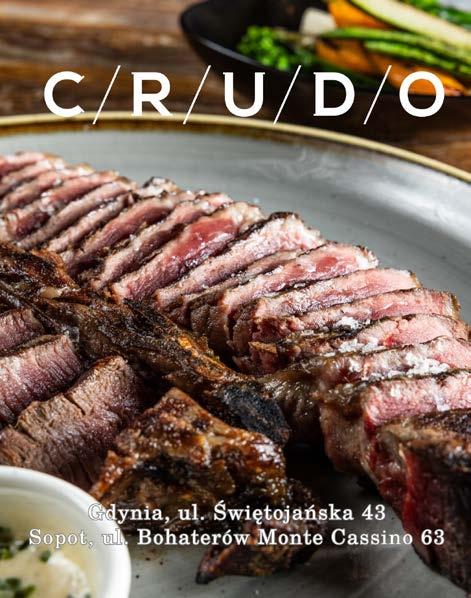







How to Use This Guide
Gdańsk In Your Pocket is designed to provide you with all of the ideas, inspiration, tools and information you need to explore the Tri-city on your own, stay offline as much as possible, and truly connect with the places you’re visiting.
Our guidebook primarily consists of two types of content: Essentials and Walking Tours
Essentials
Read these features to gain an overview of the most essential sights, experiences, tastes and touchstones of the Tri-city. Establish your
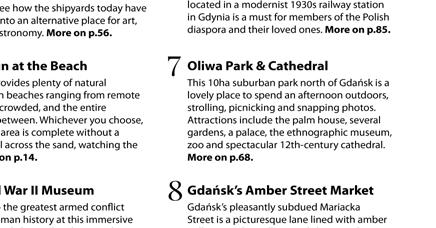
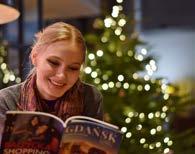
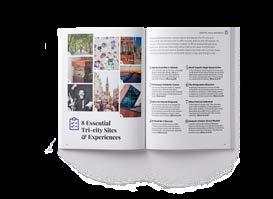
QR Codes lead you to our website when there’s more worth knowing than fits in print.
Walking Tours
Follow these to find all of the most interesting and important sites, and learn what makes them worthy of inclusion. Be your own tour guide.
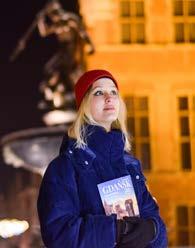
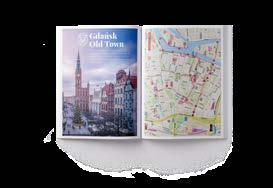

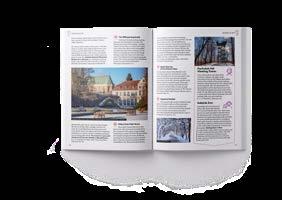
Choose your adventure the route based on your interests and impulses.
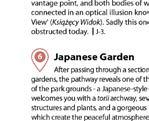
correlate to the grid on the walking tour maps, or the Gdańsk City Centre map on the inside cover, so you can gauge the distance between points and keep your bearings.

Editor’s Picks
As you go through the guide, keep an eye out for these icons next to venues that we personally recommend for the following
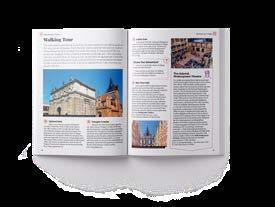
The Honeymooders
Romantic spots recommended for couples.
The Kinderguardian
Fun places designed for families and kids.
The Sophisticationer
Niche places for history buffs and culture hounds.
The Offbeatnik
Alternative, artsy or obscure places for urban adventurers.
Welcome to the Tri-city!


While this guidebook is snappily named Gdańsk In Your Pocket, it actually covers the region that locals refer to as Trójmiasto, or 'the Tri-city.' Quite simply, the Tri-city consists of three separate citiesGdańsk, Sopot and Gdynia - each proudly independent, each with its own city government, and, most im portantly, each with its own unique history. All three are positioned along the Baltic coast, with Gdańsk to the south, Gdynia to the north, and only about 20km of shoreline separating them - in the middle of which is Sopot.
To wrap your head around this whole 'Tricity' situation, see the map on the inside cover!
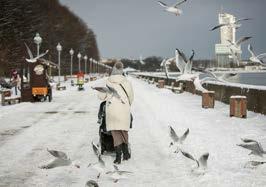
With each city well-connected via public transport (p.34), it’s not uncommon for locals to spend the day at the beach in Gdynia, have dinner in Gdańsk and then go out for drinks in Sopot, for example. Though steady development over the last 70+ years has essentially turned the Tri-city into one continuous coastal conurbation, each city, and each district of each city, has retained its own unique character, which is what makes hopping between them so rewarding in the first place. This guide encourages you to do just that, with detailed information organised by district. Before you hit the streets, however, let’s get some background on where you’ve just arrived.

1. GDAŃSK
The oldest, largest, and most well-known member of the Tri-city, Gdańsk has been a culturally diverse, cosmopolitan city for centuries. In fact, locals have historically described themselves not by nationality, but as ‘Danzigers’ (to use the German name) or ‘Gdańszczanin’ (to use the Polish), demonstrating the unique nature of this freethinking city. Founded by Polish ruler Mieszko I in the 10th century to be part of a coastal trade route, Gdańsk has changed hands innumerably over the centuries, but remained a major port through it all. It’s even been its own city-state twice in history, most notably as the ‘Free City of Danzig’ (1920-1939).
As the main tourist destination in the region, Gdańsk offers visitors a gloriously rebuilt Old Town (p.38), complete with cobbled streets, stunning Renaissance architecture and a picturesque riverfront. Rich in history and maritime culture, Gdańsk was also the scene of two of the key moments of the 20th century: it was here that the first shots of WWII were fired (p.28), and the first cracks in the Iron Curtain were forced open by the Solidarity social movement (p.57) forty years later. Today, arguably the city’s two most important attractions are the peerless World War II Museum (p.32), and the European Solidarity Centre (p.59), which you’ll find near the historic Gdańsk Shipyards.

2. SOPOT
One of the most famous, fashionable towns in Poland, Sopot’s modern history began with the building of a bathhouse and spa by a retired doctor in the early 19th century. The spa town quickly grew - first as part of the German Empire, then the Free City of Danzig - as Sopot became the preferred playground for Europe’s ruling classes, many of whom had summer homes here. Today, Sopot’s sandy beaches, top-class hotels and spas,
and kilometres of bike paths and forest trails have kept it a popular place for relaxation, but it’s also known for its energetic nightlife making it the Tri-city’s primary party destination. Lined with bars, restaurants and clubs (p.80), the main pedestrian thoroughfare - known locally as ‘Monciak’ - is one of the most happening places anywhere in the summer, leading hundreds of tourists to the city’s packed beaches and iconic pier (p.78).

3. GDYNIA
Gdynia was a quiet fishing village until the League of Nations created the ‘Free City of Danzig’ out of Gdańsk and Sopot in 1919. Finding itself at the end of the ‘Polish Corridor,’ a narrow strip of land that gave newly-independent Poland much-needed sea access, Gdynia became the focus of intense development, and by 1926 a new port city had emerged on the Baltic. Built to embody Polish autonomy and challenge the influence of Gdańsk,
Gdynia plays the yang to Gdańsk’s ying even today. A true 20th-century city, the city’s architecture reflects its development during the 1920-30s Modernist period, the post-war Socialist era and the modern post-communist era. Boasting some beautiful coastline and a diversity of restaurants and bars (p.91), enjoy exploring Gdynia’s beaches, waterfront and marina, and make a visit to the incredibly moving Emigration Museum (p.85).


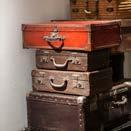






Brilliantly blending history, culture, nature and leisure, the Tri-city and surrounding seacoast have a lot to offer tourists, even in the off-season. It’s enough to flummox some itinerary makers, or fill an exasperatingly long guide such as this one. That’s why we’ve tried to hit upon the thematic highlights over the next several spreads, beginning here with a cheat sheet of the area’s absolutely most unmissable places to go and things to do.
1 Walk the Royal Way in Gdańsk
Go for a stroll through the Old Town of Gdańsk along the former path of kings, taking in the city’s grandiose architecture, historical monuments and charming atmosphere en route to the riverfront. | More on p.38.
2 The European Solidarity Centre
Learn how local shipyard workers in Gdańsk stood up to the communist authorities, unified the nation, and instigated the downfall of the communist system in Poland and across Europe. | More on p.59.
3 Explore the Gdańsk Shipyards
The site of worker protests that changed the course of history, today this area is not only filled with industrial and historical intrigue, but also taking on a second life as the location of art studios and galleries, concerts, street food vendors, bars and clubs. | More on p.56.
4 The World War II Museum
Dig deep into the greatest armed conflict in modern human history at this immersive museum, fittingly located in the city where it all officially began. One of the finest museums in Europe. | More on p.32.
5 Stroll Sopot’s High Street & Pier
In the offseason Sopot reveals its artistic side. Stroll down to the end of the pier or top of the lighthouse, pad through the woods or across the sands, and discover why so many people are inspired by this place. | More on p.74.
6 The Emigration Museum
Explaining the dynamic history of Polish emigration, this fascinating portside museum located in a modernist 1930s railway station in Gdynia is a must for members of the Polish diaspora and their loved ones. | More on p.85.
7
Oliwa Park & Cathedral
Full of lights in winter, this 10ha suburban park north of Gdańsk is a lovely place for a brisk stroll outdoors. Among the park’s many attractions are a palm house, palace, two museums and a spectacular 12th-century cathedral. | More on p.68.
8 Gdańsk’s Amber Street Market
Gdańsk’s pleasantly subdued Mariacka Street is a picturesque lane lined with amber galleries and jewellery workshops. A charming setting to search for that piece of amber that speaks to you. | More on p.43.

Worthy Winter Attractions
Although more of a summer destination, locals know: winter on the Baltic also has its charm. The days may be shorter and the temperatures frostier, but without the high-season crowds and commercial kitsch, the Tri-city possesses an aura of authenticity and an undeniable natural beauty. Here are a few area highlights for warding off the winter blues and even celebrating the offseason.
Aleja Lipowa in Oliwa Park (p.68) during winter.

1Holiday Lights in Tri-City
Until approx. the end of February
Old Saint Nick may have come and gone, and with him the area’s holiday markets, but the festive mood prevails around Gdańsk nonetheless with illuminated decorations on show until early February. One place particularly worth seeking out is Oliwa Park (p.68), where each year the peaceful gardens surrounding the old monastic grounds are powered up with thousands of tiny Christmas lights, making a visit here an annual tradition for many local families. Among the wondrous illuminated installations will be the huge curtains of light that go up each year along both sides of Aleja Lipowa (Linden Avenue, p.69), and dozens of glowing water lilies will be making their debut along the park’s canals in 2023/24. Many of these installations could be considered light sculptures, and you never know what you’ll see, from sailing ships to peacocks. Many items recognisable from previous years will also be illuminating popular corners of the Old Town after dark, including Długi Targ (C-6), Plac Kobzdeja (C-5, near Gdańsk Market Hall, p.46), the Green Bridge (D-6, p.53) and Targ Węglowy (B-5/6), and the centres of Sopot (p.74) and Gdynia (p.82).
Outside of Gdańsk’s historic centre, there are more luminations to leer at. However, unlike Oliwa’s seasonal lights, the following mentioned here are paid entry. Lumina Park, which was originally set to spark up on Góra Gradowa, has been forced to relocate to Pruszcz Gdański due to objections from local residents. Thematically, this venture promises a mesmerising journey through the wonders of science - from ancient sun worship, to Copernicus and Newton, through to humankind’s quest to reach the moon.
Visit www.luminapark.pl for full ticket prices. To get there, take bus 132, 232, 207, 205, N5, or the regional PKP train.
Gdynia Orłowo will once again host Ogród Świateł (Garden of Lights) - a family attraction featuring dozens of complex light installations in the openair. This year’s theme is The Smurfs, and will feature characters from the cult cartoon, the clever Papa Smurf, the charming Smurfette, the wise Dragonfly, and the sinister Gargamel and his feline companion Azrael! This one is particularly good for young families, as children under 100cm in height only pay 1zł!
Visit www.gardenoflights.com for full ticket prices. To get there from Gdańsk Old Town, hop on the SKM train to Gdynia Orłowo.
Seasonal lights in Oliwa Park (p.68)
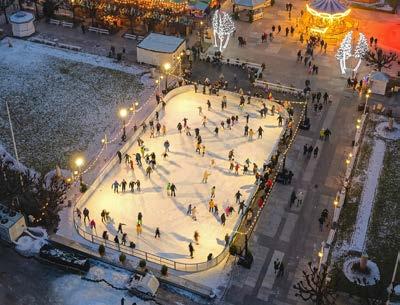
Open-Air Ice Skating
Until approx. the end of February
Of course every self-respecting city needs an outdoor ice rink in winter, and Gdańsk is no exception. With no large, spacious market square (in the traditional European sense) to slap it on, Gdańsk’s most centrally-located ice rink is on Targ Sienny (B-5) this year, near the Forum Gdańsk shopping mall. While quite a commercially convenient location, it also happens to be right across from the start of our Old Town Walking Tour (p.40), so don’t expend all your energy on the ice if you haven’t walked down the Royal Route yet.
In terms of location, there’s no beating Sopot’s outdoor ice rink on Skwer Kuracyjny (N/O-6),
right in the social heart of the city, and just metres from the beach and pier. Turn your triple salchows while taking in the curative seabreeze, and if you’re able to get there by January 7th, you’ll be able to enjoy their extended holiday market and a Victorian carousel.
Gdynia, for their part, also has a couple outdoor rinks, the best of which is located in Park Centralny along ul. Piłsudskiego, within a few minutes walk of Gdynia Wzgórze Św. Maksimillian train station (Q-5). As such, it makes the perfect last stop for anyone following our Gdynia Walking Tour (p.90).
Sopot Beachfront Saunas
Until the end of April
Known locally as morsowanie (literally ‘walrusing’), stripping down and jumping into the freezing waters of the Baltic Sea is a popular winter pastime around the Tri-city. While invigorating to be sure, there’s also a certain insanity to the activity, especially when it ends with one shivering on the sand in their skivvies. But what if you had a sauna directly on the beach that you could duck into afterwards, or even relay back and forth between the saltwater and the steam room to your heart’s content?
Sopot, spa town that it is, offers exactly that. Operated by the fantastic beachfront restaurant M15, just a 10min walk north of Sopot Pier you’ll find a cluster of modern wooden saunas fitting up to a dozen people each, with changing rooms and big windows staring out to sea. 90mins of sauna access is only 59-79zł, or rent out an entire sauna cabin for yourself and friends. They also offer aromatherapy sessions, and can organise additional attractions like fire dancing shows. A great way to relax or turn a special night into one most memorable. | ul. Mamuszki 15, Sopot. Open 08:00-22:30; Mon 07:0022:30; Fri 08:00-23:30; Sat, Sun 07:00-23:30. www.m15. sopot.pl.
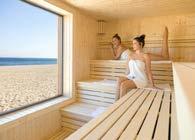
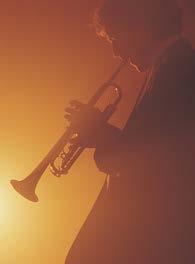
Live Music for Cold Ears
All winter long
Looking to catch a band? Winter is a good time for it! The newly revived KOT (B-5, ul. Garncarska 18/20) aims to reclaim its position as the live music venue in Gdańsk Old Town, with their in-house cocktail and wine bar Monk (p.55) rustling up a program. All the open-air alternative venues in the shipyard district (p.56) may be closed for the season, but that doesn’t mean there’s no activity - Check out Montownia (p.61), Wydział Remontowy (C-2, Pl. Solidarności 1) or one of Elektryków Street’s concert venues (p.60). In Wrzeszcz, it’s all happening Stary Maneż and Peron 5 within Stacja Food Hall (p.67). In Sopot, Teatr BOTO (p.81) is a local favourite, especially for their blues jam nights on Mondays and jazz sessions on Thursdays. Gdynia’s Blues Club is worth the trip up from Gdańsk, so too is Klub Desdemona (both p.91).

Local Flavours & Spirits
Gastronomy in the Tri-city region is a microcosm of Polish, German, Kashubian and Scandinavian culinary traditions, supplemented by the rich bounty of the Baltic Sea and a long tradition of brewing and distilling alcohols. The result is a unique culinary profile that separates itself from the rest of Poland. You'll find our local recommendations for where to eat and drink at the end of each walking tour; what follows is an edible itinerary and to-do list of tipples. Smacznego, and na zdrowie!
Food - Coast and Heartland
Most staples of Polish cuisine can be found in local restaurants, however, you’ll also find dishes on the menu that are far more common in the Tri-city, as well as Kashubia and Pomerania at large. Note that addition of fruits and berries into meat dishes is a very Kashubian habit, as is their love of pickling just about everything, while cooking with goose meat is equally as Pomeranian as it is Kashubian!
1 Śledź po Kaszubsku
'Kashubian-style herring' is essentially pickled herring combined with raisins or even chopped apple. One variation has cream stirred in as well. On the topic of seafood, other popular Baltic catches to look out for are dorsz (cod), mintaj (pollock), flądra (flounder), łosoś (salmon), makrela (mackerel).

3 Lard on Bread
Smalec (animal fat) slathered on bread seems to be far more popular in the north of Poland than anywhere else in the country. You are guaranteed to find this particular culinary piece at any big market event that comes to town, even in the middle of summer when such a heavy delicacy seems a bit unnessecary!


2 Goose Meat
A cultural overlap of German Pomeranian and Kashubian cuisine, Gęś (goose meat) would appear to have made its way into Polish cuisine from the north. Keep an eye out for Goose paste with lard and also Gęsie Nogi (Goose Legs) which is often served with roasted apples.

4 Żurek
It doesn’t get any more Polish than żurek – a sour soup made from a thick stock of fermented rye flour. Typically chock full of potatoes, sausage and hard-boiled eggs, żurek is often thickened with cream, and seasoned with marjoram, garlic, salt and pepper.

6
Bigos
Though there’s no standard recipe for this hearty stew, ingredients usually include fresh and pickled cabbage, pork, sausage, onion, mushrooms, plums, peppercorns, bay leaves, caraway and whatever else is on hand. In fact, metaphorically bigos translates to ‘big mess,’ ‘mish-mash’ or ‘confusion’ in Polish.
5 Barszcz
A popular liquid-form dish in the Slavic culinary sphere, barszcz (elsewhere known as borsch, borshch, borsht, or bortsch) is a nourishing beetroot soup. In Poland, it may be served with a croquette (z krokietem), with mini pierogi floating in it (z uszkami), or simply as broth in a mug expressly for drinking (solo).


8
Placki Ziemniaczane
Savoury, fried potato pancakes, similar to hashbrowns or Jewish latkes. Served in a variety of ways - with sour cream only (placki solo), smothered in mushroom sauce or goulash (placki po węgiersku). Highly caloric, these gloriously greasy serves are also a tried and true hangover cure!
TRY IT HERE:
Pierogarnia Mandu
- B-4, ul. Elżbietańska 4/8, Gdańsk Old Town
Swojski Smak
- C-3, ul. Jana Heweliusza 25/27, Gdańsk Old Town
Bar Przystań
- O-9, Al. Wojska Polskiego 11, Sopot
7 Gołąbki
Oddly translated as ‘little pigeons’, this this popular dish could be described as a ‘cabbage enchilada’. In lieu of tortilla bread, cabbage leaves are filled with rice, onion, and minced pork (though vegetarian versions are also common), then baked or steamed and topped with tomato or mushroom sauce.

Polskie Smaki
- N-6, ul. Powstańców Warszawy 10 (Sheraton Hotel), Sopot.
Tłusta Kaczka
- Q-12, ul. Spółdzielcza 2, Gdynia Orłowo Oberża 86
– Q-3, ul. Starowiejska 30, Gdynia

1 Grzaniec
Grzaniec is shorthand for Grzaniec Galicyjski - a popular Polish brand of red wine which is almost exclusively used to make hot mulled wine (grzane wino). A common sight at Christmas markets and other winter fairs, a couple cups of this sweet defrosting fluid will put you in a right jolly mood. You can also order it from most bars during the frigid season, and find it bottled in alcohol shops if you want to try making it at home; just put it on low heat, throw some more spices and orange slices in if you’re feeling fancy.
2 Grzane Piwo
That’s hot beer in local layman’s terms – essentially a frothing hot pint of lager spiced with flavoured syrup, clove, cinnamon and other mulling spices. For some it’s an acquired taste, for others an early Christmas present and others still an utter profanity, but everyone should try it at least once. To order one at the bar you’ll need to know which syrup you want: imbirowy (ginger) or malinowy (raspberry). This decision is usually made along gender lines, likely due to the fact that raspberry syrup results in a pint of warm pink beer. Be aware that it takes some time to prepare, and make sure you let it cool off before putting a straw in or it might erupt on you.
3 Krupnik na Gorąco
Essentially the Polish hot toddy, this is the perfect warm-up drink, particularly if the sweetness of the previous two is too much for you. Krupnik na gorąco just means hot Krupnik, which any bartender knows means a healthy shot of honey vodka (Krupnik), plus hot water, cloves and other wintry spices, and slices of lemon and/or orange. The perfect drink for people who shouldn’t be drinking, if you’ve got a sore throat or are feeling a bit under the weather, hot Krupnik is the appropriate remedy.
Warming Winter Drinks

Must-try Tipples
1 Nalewki
Although Poland is most often associated with clear, potato-based vodka, flavoured tinctures made from fruit, herbs and spices - known as nalewki - are arguably more popular, and certainly more palatable. Flavours can range from cherry to quince to hazelnut, and many restaurants and bars make their own house batches. More for sipping than shooting, make sure that you expand your knowledge of vodka and its many varieties beyond the clear stuff.
: TRY IT HERE:
Wiśniewski - C-6, ul. Piwna 22, Gdansk.

2 Goldwasser
A celebrated Gdańsk tradition since 1598, Goldwasser is a unique alchemic elixir characterised by the 22 karat gold flakes floating in it. One of the oldest liqueurs in the world, Goldwasser’s secret recipe contains some 20 roots and herbs, combining to create a sweet, but spicy flavour with touches of anise, pepper and mint. This is the ultimate souvenir of Gdańsk, and can be consumed in numerous restaurants and bars around Tri-city.
: TRY IT HERE:
Goldwasser Restaurant - D-6, ul. Długie Pobrzeże 22, Gdańsk.
Targ Rybny - Fishmarkt - D-5, ul. Targ Rybny 6C, Gdańsk.
3 Machandel
Once described as the ‘State Drink of Danzig,’ Machandel is a strong juniper-based liqueur with a smooth taste and firm kick. Originally produced by the Stobbe family in the nearby town of Tiegenhof (now Nowy Dwór Gdański), Machandel had been out of production since WWII, but has recently been revived using the original recipe and is once again available in select Gdańsk restaurants.
: TRY IT HERE:
Goldwasser Restaurant - D-6, ul. Długie Pobrzeże 22, Gdańsk.
Gdański Bowke - D-6, ul. Długie Pobrzeże 11, Gdańsk.
Targ Rybny - Fishmarkt - D-5, ul. Targ Rybny 6C, Gdańsk.

Pre-war ad
4 Okowita
Also known as bimber, the word ‘okowita’ comes from the Latin ‘Aqua Vitae,’ a spirit distilled 3 times to achieve an alcoholic strength of up to 80%. Okowita arrived in Poland in the 16th century via either Germany or Italy, originally being available mainly to the wealthy bourgeoisie. Also produced from grain or potatoes, it is notably more aromatic than vodka, and has thus maintained its status amongst the most refined of spirit connoisseurs!
: TRY IT HERE:
Podole Wielkie i Przyjaciele - C-6, ul. Chlebnicka 37/38, Gdańsk.
Tłusta Kaczka - Q-12, ul. Spółdzielcza 2, Gdynia Orłowo.
Shots of Goldwasser; courtesy of Wyspa Północ restaurant.
demonstrating the proper way to drink Machandel.

Local Craft Beer
Without a doubt the most Germanic thing to rub off on Polish society, 16th-century Danzig grew to dominate the regional brewing market with some 400 breweries in operation, most located on aptly-named ul. Piwna (Beer Street). While Poland is still stereotyped as a nation of vodka drinkers, the numbers show that far more beer is consumed today. Gdańsk has embraced its roots and global craft beer trends, reopening several historic ‘bier kellers’ as modern microbreweries in recent years. Multitap bars, brew pubs and microbreweries have popped up across Pomerania, and some local beer brands have even gone national, including AleBrowar and Browar Amber.
TRY IT HERE:
Brovarnia
D-6, ul. Szafarnia 9, Gdańsk. Piwnica Rajców
C-6, ul. Długi Targ 44, Gdańsk.
Browar PG4
B-4, ul. Podwale Grodzkie 4, Gdańsk. Nowy Browar Gdański
F-4, ul. Jana Kilińskiego 7E, Gdańsk Wrzeszcz. No.5
M-6, ul. Bohaterów Monte Cassino 5/U2, Sopot. AleBrowar
P-3, ul. Starowiejska 40B, Gdynia.
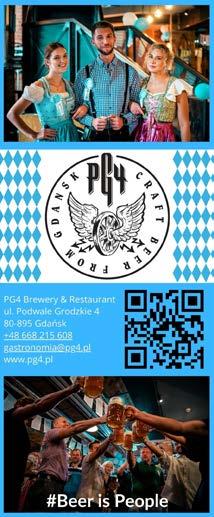
A new generation of beers and beer drinkers at Nowy Browar Gdański.
Gifts & Souvenirs
It's only natural to want to pick up a local souvenir, or find a nice gift that shows your friends and loved ones you were thinking about them while throwing back those pints. The key to success is knowing what to look for and where to find it. Here's hoping our suggestions lead you to a suitable item that supports the local economy, and won't spend its future days in the back of a drawer. Happy hunting!
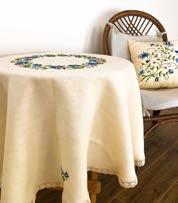

A bona fide shopping destination full of modern malls, follow the link for more info on Tri-city shopping.

1 Amber
At the absolute top of any such list would be amber, otherwise known as ‘Baltic gold.’ Gathered and prized for its colour and beauty since the beginning of humankind’s existence in the area, amber is actually the resin of ancient trees that has been buried in sedimentary rock and, after millions of years, washes up on the beach in the form of a semi-transparent golden-hued gemstone. Amber often astounds us with its ‘inclusions’ of prehistoric insects and plant matter suspended inside. The creation of amber jewellery and works of art is a tradition that has existed in the Tri-city since the Middle Ages and booths selling crude amber jewellery can be found all over town. For a more discerning selection, you’ll find many charming amber galleries along Gdańsk’s ul. Mariacka (p.43), at the gift shop of the Amber Museum (p.47).

Kashubian Handicrafts
The Tri-city is where Kashubians, one of the largest surviving ethnic minorities in Europe, have been plying their trades for centuries. Described as a cultural mix of Polish and German, Kashubians particularly pride themselves on their embroidery which uses just five colours: green, red, yellow, black and blue, the latter of which comes in three distinct shades. Distinct regional folk patterns in these colours can be found on everything from clothes to ceramics. Kashubian handicraft masters are also known for their wood carvings and handwoven baskets. A wonderful place to get such fine, folky things is Galeria Sztuki Kaszubskiej - a small family gallery found at ul. Św. Ducha 48 in Gdańsk (C-5).
2
Local Spirits
Poland has distilling and draining quality vodka since the Middle Ages, and as such it makes a perfect last-minute duty-free purchase. Gdańsk, however, boasts several unique local spirits you’ll be challenged to find elsewhere (see p.22). Most famous among them is Goldwasser - one of the oldest liqueurs in the world, dating back to the late 16th century. Characterised by the 22-karat gold flakes floating in it, the secret recipe contains some 20 roots and herbs, combined to create a sweet-yet-spicy flavour with touches of anise, pepper and mint. You can pick up a bottle at the official Goldwasser Restaurant on the Old Town Waterfront (D-6, ul. Długie Pobrzeże 22).
A lesser-known spirit from Gdańsk is Machandel, a strong juniper-based liqueur with a smooth taste and firm kick. Recently revived after being out of production for 60+ years, you’ll also find it for sale at the Goldwasser Restaurant; see above. Similarly, Okowita - the region’s own version of Aqua Vitae from another epoch - has also made a return to the market, and you can pick up a bottle of this high percentage aromatic spirit from Podole Wielkie in Gdańsk Old Town (C-6, ul. Chlebnicka 37/38).

Goldwasser gift set from the restaurant of the same name.
Embroidered Kashubian folk patterns.
3 Solidarity Swag
Solidarność (Solidarity) is a Polish trade union born out of the Gdańsk Shipyards (p.57), which was the first independent organisation to be recognised behind the Iron Curtain. Making headlines across the world for resisting (and ultimately triumphing) against the communist system in the 1980s, Gdańsk and the iconic red ‘Solidarność’ logo are now inseparable, and you’ll find no shortage of merchandise and memorabillia from small vendors and souvenir shops around the Old Town. For an even bigger selection of Solidarity shirts, mugs and more, visit the shop at the European Solidarity Centre (p.59), though buying such items from the gift shop at the nearby BHP Building museum (p.59) apparently goes straight to supporting the trade union.


4 Günter Grass' Danzig Trilogy
Undoubtedly the most famous novel set in Gdańsk/Danzig is The Tin Drum by Nobel Prize-winning author Günter Grass (19272015). About a hyperintelligent boy named Oskar Matzerath, who, amidst the political turmoil of the interwar-period, refuses to grow up, the controversial novel is a classic of post-war German literature and magical realism. Much of it was inspired by Grass’ own experiences growing up in the Wrzeszcz district of Gdańsk (p.62), where visitors will find many references from the novel today. Originally published in 1959, The Tin Drum is the first and most famous book of what is now known as Grass' 'Danzig Trilogy.' The second, Cat and Mouse, published in 1961, follows Joachim Mahlke, an alienated only child who has grown up fatherless in Nazi-controlled Danzig before and during WWII. Dog Years, published in 1963, takes place at various times between the 1920s and 1950s, and follows the friendship of Walter Matern and his half-Jewish friend Eduard Amsel.
As with the other two novels, Danzig's complex political, multiethnic, and multireligious identity is a key driving force btween the two characters' relationship.
Political poster portraying the 1989 elections as 'high noon.'
Boutique - Atelier
Symbols of precious moments

MARK STORIES OF YOUR LIFE BY CREATING UNIQUE ENGRAVED JEWELERY
GDAŃSK 126 Ogarna Street, MATARNIA 26 Złota Karczma Street, GDYNIA 56 Świętojańska Street, RIVIERA 2 Kazimierza Górskiego Street
lilou.pl
World War II Legacy

World War II looms large over the Tri-city, and a certain degree of knowledge about the region’s role in the conflict is essential for understanding its historical significance and contemporary character. Only two decades after what had been erroneously referred to as ‘The War to End All Wars,’ World War II would prove to be the most global and most deadly conflict in human history. And it began right here in Gdańsk....
The Long Market (Długi Targ) and Main Town Hall in ruin, 1945.
PRELUDE
Gdańsk (then Danzig) had long been caught in a tug-of-war between Germany and Poland, and the decision by the League of Nations to make it a Free City State following World War I left neither side happy. While the two communities continued to live together as they had for centuries, politically speaking, Danzig was very much divided: the Germans controlled the State senate, the police and much of the business, while the Poles dominated the railways, port authority and even had their own postal service. After the election of Hitler in neighbouring Germany, bitter rivalries came to the surface, anti-Polish sentiment spread rapidly, and by 1935 the local police force had started keeping tabs on any Pole seen as a threat to German interests.
The rise in tensions wasn’t a shock to the Poles. In 1925, the League of Nations bowed to pressure and consented to the deployment of a token 88-man Polish force across the water from the Free City on the Polish-controlled Westerplatte Peninsula (p.33). As Hitler’s posturing became ever more threatening, the Poles continued to covertly strengthen their foothold, smuggling in military hardware and secretly building fortifications in breach of League of Nations decrees.

OUTBREAK
On August 31, 1939, Nazi units dressed in Polish uniform infamously staged a mock attack on a radio tower in the German border town of Gleiwitz (now Polish ‘Gliwice,’ in Upper Silesia). Photos of the charade were flashed across the world, with Hitler claiming a provocative attack by the Polish army. The following dawn, Germany launched a strike on Westerplatte, an attack that would ultimately kick off World War II. Popular theory asserts the first shots of the war were fired from the German warship the SMS Schleswig Holstein, supposedly visiting Gdańsk on a goodwill mission. In actual fact, logbooks
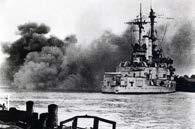
recovered by the Nowy Port Lighthouse across the water from Westerplatte prove beyond doubt that the German battleship was pre-empted by a matter of three minutes by a Nazi gun emplacement halfway up the lighthouse. Shocked, but ready, the Poles scored a direct hit on the lighthouse, thus in all likelihood making the German lighthouse gunners the first casualties in a war that would go on to claim 55 million lives. The German shelling of Westerplatte was simultaneously supported by infantry attacks on the Westerplatte gateway, with the Polish defenders repelling repeated advances by German navy storm troopers. At precisely the same time, another equally ferocious battle was being waged at the Polish Post Office Building (p.33) in Gdańsk’s then-named Hevelius Square. Detachments of German police and SS laid siege to the 50 Polish post workers inside, who put up a brave struggle for over 17 hours until casualties became intolerable, part of the building collapsed and the Germans began to attack with flamethrowers.
SMS Schleswig Holstein shelling Westerplatte, September 1, 1939.
German troops taking Westerplatte, September 1939.

SIEGE
Yet while the post office capitulated, the garrison at Westerplatte held on. As for backup, the Polish navy in Gdynia (Poland) unfortunately failed to mobilise, while the air force based in Puck was destroyed before they could get off the ground. Polish customs officers succeeded in blowing up the bridge in nearby Tczew and slowed the German advance. Britain and France declared war on Germany on September 3rd, but hopes of outside help being directed to Poland proved ill-founded. On the morning of September 7, Major Henryk Sucharski gave the order to raise the white flag. Gdynia surrendered two weeks later, and would be later renamed Gotenhafen (literally meaning ‘Goth Port’). The Hel peninsula - the final Polish stronghold in Pomerania - fell on the 2nd of October, by which time Poland had been invaded from the east by the Soviet Union. Ironically, Hel (p.93), would also be the last place the Nazis would relinquish in 1945.
UNDER THE REICH
Despite his oft-spoken desire to incorporate Danzig into the Reich, Hitler made only two visits to the Tri-city, apparently due to his deep suspicion of Danzigers and fear of assassination. The second of these visits came on September 18, 1939, with an exultant Führer arriving in Sopot (then Zoppot) via his armoured train, and checking into the Kasino Hotel (today the Sofitel Grand, see p.78). His stay lasted a week, during which time he received a delegation from Japan, visited the Schleswig-Holstein, Westerplatte and inspected a parade outside Artus Court on Gdańsk’s Long Market (p.42).
By that time, fervent Nazis were already clamouring to rid the region of all traces of Polonisation. The Polish intelligentsia and other political targets were arrested and incarcerated in numerous camps and prisons, including the Victoriaschule (ul. Kładki 1, B-5), the city jail (now replaced by a newer model) and Stutthof - later to morph into a notorious death camp (p.93). Flags, signs and anything remotely Polish was destroyed.
Governor and Gauleiter (Regional Nazi Leader) of the city was Albert Forster, and his reign still arouses controversy and debate among both scholars and survivors. Unlike other Gauleiters in annexed and occupied territories, Forster followed a programme of assimilation, granting thousands of locals German citizenship if they swore German heritage. Even more remarkably, those Poles rounded up and persecuted in the first wave of arrests could seek

Długa Street (C-6) hung with Nazi banners, 1940.
The captured defenders of the Polish Post Office (p.33)
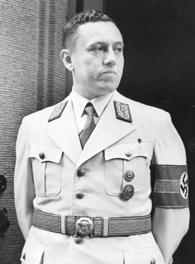
German citizenship, and even pursue restitution for any property originally seized. Benign by some benchmarks, Forster was a model Nazi on others. Jews faced merciless persecution, and Stutthof (p.93) emerged as a true place of terror and he is thought to have personally given the execution orders for over 2,000 Poles between 1939 and 1940.
FINALE
For ordinary Danzigers, the quality of life remained relatively good for much of the war. Sopot was a favourite stomping ground for Nazi soldiers on R&R, and in spite of rationing and occasional shortages, life didn’t get worse for many locals until the closing stages. The first signs that all was not well came with Allied air raids on the Shipyards - home to munitions factories producing U-Boats and V1 and V2 rockets - and the Zaspa Airfield. By 1945, Danzig’s population had swelled to 1.5 million due to refugees fleeing from the east, the Red Army was fast approaching, and the city was on the precipice of chaos as it became a regular target for bombing raids. Authorities designated Danzig a closed Nazi
fortress, or Festung, and its defence proved bitter and bloody. Historian Antony Beevor wrote of the ensuing siege:
‘Fighter bombers strafed the towns and port areas. Soviet Shturmoviks treated civilian and military targets alike. A church was as good as a bunker, especially when it seemed as if the objective was to flatten every building which still protruded conspicuously above the ground... Tens of thousands of women and children, terrified of losing their places in the queues to escape, provided unmissable targets.’
During this time, Albert Forster fled west and went into hiding in the British Occupation Zone. More than year after hostilities had ceased, he was found and extradited back to Poland. His death remains a mystery - some claim he was hanged in Biskupia Góra after the war, while others insist it was his body double. Yet more sources claim he was taken to Warsaw’s Mokotów Prison and beaten to death. The truth may never be confirmed.
Sopot fell on March 23, Gdynia on March 28. Encircled and out-powered, Danzig was given the opportunity to surrender, but continued fighting; that fires were burning a month later is testament to the ferocity of the siege. The Red Army finally entered the city on March 30. Gdańsk/Danzig, scene of the first shots of the war, now lay ablaze and in ruins. Furthermore, the city’s ‘liberators’ were the foreshadowing of Poland’s next chapter - the Polish People’s Republic (PRL) and 44 years of communist rule.

Gdańsk, destroyed by air raids and fire, 1945.
Albert Forster, Nazi Gauleiter of Gdańsk.

Worth Visiting
1 World War II Museum
A 15min walk north of the Old Town, this is Gdańsk’s top museum. As such, you need to plan your visit. Entrances are timed and tickets should be bought in advance from their website. Those interested in the topic can easily spend a whole day there, and we recommend you allot yourself at least 3 hours. We also strongly recommend spending the extra 12zł on the excellent multilingual audioguide.
The heart of the museum is the permanent exhibition which is split into three parts –‘The Road to War,’ ‘The Horror of War' and 'The Long Shadow of War’. There is also a separate permanent exhibition for children, and several temporary exhibits at any given
time. Numerous films, photographs and excellent translations improve the experience, but it’s the collection of donated artefacts highlighting personal tragedies that make the biggest impression. Aside from the museum’s broad international scope, there is also an emphasis on the Tri-city’s wartime experience and the war’s lasting legacy for Poland and its people. The building also includes a library, cinema and two restaurants. Make the time, get your tickets and don’t miss this one. Visiting time: 4hrs.
E-4, Plac Władysława Bartoszewskiego 1, Gdańsk. Open 10:00-18:00; Tue 10:00-16:00; closed Mon. Admission 29/22zł; family ticket 60zł; Tue free.
Defenders of the Polish Post Office monument.
2 Museum of the Polish Post Office
The site of the famed siege, where some 50 heavily-armed postal workers bravely stood their ground against the German SS over the course of 17 gruelling hours, today the Polish Post Office is still just that - a post office - but also a small-but-compelling museum dedicated to the events of September 1, 1939, as well as local postal history from the 18th century to the outbreak of WWII. An impressive stainless steel monument outside the Post Office honours their sacrifice, which has become one of the most romanticised tales of heroism in Polish history. If you aren’t up for the WWII Museum, this is a worthwhile (and much less ambitious) back-up option. Visiting time: 40mins.
D-4, Plac Obrońców Poczty Polskiej 1-2, Gdańsk 10:00-16:00; Thu 10:00-18:00. Admission 15/10zł, Mon free.
3 Westerplatte
Westerplatte first sprang to fame as a health resort in the mid-19th century, before achieving infamy as the Polish military zone where the opening shots of WWII were exchanged. Today, the site is a historical park and memorial featuring a scattering of bunkers, burnt-out ruins, an enormous communist-era monument, snack bars, souvenir stalls and a small museum in Guardhouse Number 1 (closed October to April). There is also an outdoor exhibit entitled ‘Westerplatte: Spa-Bastion-Symbol.’ To get to Westerplatte, catch bus 106 or 138 just outside of Gdańsk Główny train station (journey time about 30mins).
youtube.com / inyourpocket
ul. Majora Henryka Sucharskiego, Gdańsk. Admission free.
4 Stutthof Death Camp
Located in Sztutowo, about 1hr east of Gdańsk, Stutthof was the first death camp built by the Nazis on Polish soil, and the last to be liberated due to its remote location. Today a memorial site and museum, a visit is both peaceful and impactful (and free). | More on p.93.
What’s up, guys? Pierre here! If you’re enjoying this guide, then you should check out our videos on Gdańsk on our YouTube channel!

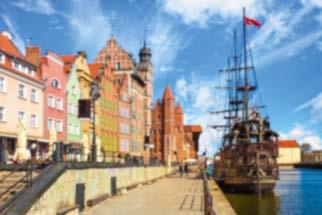



@inyourpocket
@gdanskinyourpocket
@gdanskinyourpocket
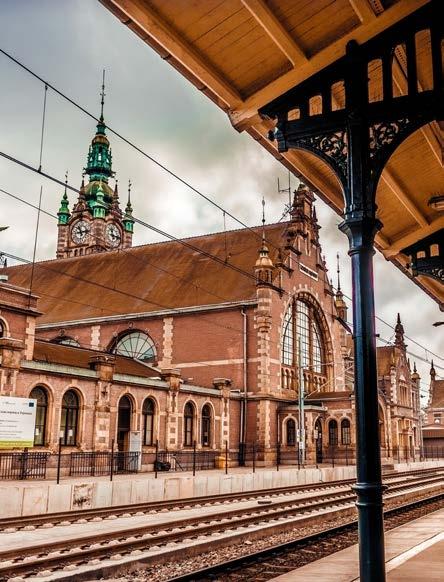
Getting Around
One of the keys to the Tri-city being ‘the Tri-city’ - and not just separate towns spread along the coast - is how wellconnected they are. Even if you don’t have a car, you can quite easily get between Gdańsk, Sopot, Gdynia and also the airport thanks to the railway network, after which you can proceed locally via tram, bus, bike or scooter - all of which is explained here.
Gdańsk Główny train station.
By Train
Unless you have your own motor vehicle, or are a distance cyclist, train will be your main mode of travel around the Tri-city. The first, most important thing you need to know is where you’re trying to go.
• ‘Gdańsk Główny’ - the main station in Gdańsk
• ‘Sopot’ - the main station in Sopot
• ‘Gdynia Główna’ - the main station in Gdynia
• ‘Gdańsk Port Lotniczy’ - the airport station
Now that you know where you’re going, how will you get there?
SKM Trains
These yellow and blue commuter trains are the easiest, most common way to travel between Gdańsk, Sopot and Gdynia (and all stops in between); though there are other trains, stick to these - you’ll be better off. SKM trains depart as often as every 10-15mins, with long wait times only between 02:00-04:00. If you don’t have the Jakdojade app, tickets can be bought from machines on the platforms, from station ticket offices (not recommended), or - as a last resort - from the conductor at the front of the train (not recommended). If you buy your SKM ticket from the station ticket office, you must stamp it in the bright yellow boxes on or close to the platform to validate them, before getting on the train. If you don’t, you risk being fined by ticket inspectors.
Tickets & Travel Times
Kids under 4 travel for free on SKM, but you must buy a 0zł ticket (we kid you not) and prove the child’s age. ISIC cards get you a discount only if you study in Poland; Euro 26 cards are not honoured. Bikes travel for free on trains, but you must enter the front carriage and place your bike on a rack. | skm.pkp.pl; rokladjazdy-pkp.pl
• Gdańsk to Sopot: about 20mins, 6.50zł.
• Gdańsk to Gdynia: about 35mins, 9.60zł.

Transport Hacks
We’re not going to pretend like transport around the Tri-city isn’t confusing for visitors. Just trying to explain it here in a simple, understandable way is a real challenge. For those who don’t want to parse all this info, here are a couple simple shortcuts. Transport sorted!
Jakdojade mobile app
Make your life easier by getting Poland’s best transport app. Jakdojade (website and app) will tell you exactly how to get to your destination using live transit connections based on your location. It includes SKM trains and all local options, and will even guide you to the necessary station on foot. If you add your bank details to the app you can also buy the exact ticket you need and validate it through the app, which is truly handy. | gdansk.jakdojade.pl
Metropolitan tickets
Don’t want another app on your phone, and also don’t want to figure out all these different tickets for different transport in different cities? We don’t blame you. Fortunately, there’s one ticket that works for SKM trains, other trains, and all local transport (except water trams) in all of the Tri-city. Buy a Metropolitan ticket for 24hrs (30/15zł) or 72hrs (68/34zł) - then validate it in the yellow boxes on train platforms, and onboard trams and buses - and you can stop thinking about transport tickets. | mzkzg.org
Airport Trains
SKM trains do not go to the airport, though some connections from Gdańsk and Sopot may include SKM travel to Gdańsk Wrzeszcz before changing trains for the airport. There is a direct train connection from Gdynia to the airport (no changes). Use Jakdojade to find airport connections, or go to the nearest main station and get a ticket from the proper ticket office.
Tickets & Travel Times
For detailed info about Gdańsk Airport, visit our website.
Gdańsk to Airport: about 45mins, 5.50zł.
Sopot to Airport: 30-40mins, 5.50zł.
Gdynia to Airport: 20-40mins, 8zł.
By Bus & Tram
Gdańsk and Gdynia have independent local transport networks, which both cover Sopot; Sopot has no network of its own.
ZTM Gdańsk
Gdańsk’s public transport consists of trams and buses, both painted red and beige, and covers all regions of Gdańsk, as well as Sopot. Single ride tickets cost 4.80/2.40zł and can be purchased via app, or from ticket machines at major stops and kiosks before boarding. Paper tickets must be validated upon boarding to avoid a fine. | ztm.gda.pl
ZKM Gdynia
Gdynia’s transport network consists of white and blue buses and trolleybuses, which cover all of Gdynia, plus Sopot. Single ride tickets cost 4.80/2.40zł and can be purchased via transport app or at kiosks. Paper tickets must be validated upon boarding to avoid a fine. | zkmgdynia.pl
Scan & Go
MeVo Bikeshare System
With flat topography, dedicated bike lanes on major roads and lovely coastal trails between each city, the Tri-city is incredibly bike-friendly; even more so with the area’s super-convenient bikeshare service. With thousands of bikes at hundreds of stations,
this ubiquitous system is affordable, works great and is certainly the most convenient way for visitors to get on a bike. With regular bikes and ‘electricassisted’ options, you can choose to ‘pay as you go’ (0.15zł per hour) or consider a 48hr subscription plan for 59zł. Simply download the app and put in your bank card details to get going. | rowermevo.pl
Bolt Scooters & Bikes
If you're already a Bolt user, you'll find that the allin-one-transport app is handy across all of Poland. If you’re not familiar, download Bolt’s free mobile app and enter your bank details to get started. In addition to functioning as an alternative taxi service - quickly connecting you with affordable, no-cash rides from local drivers - Bolt also has hundreds of electric scooters (day passes starting at 12zł), offering a cheap, easy and environmentally-friendly way to get around. Like MeVo, these scooters must be parked in designated areas, so check the map in the app to see where you can leave it before setting off on one. | bolt.eu
Traficar Car Share
Want your own car but just for a short while?
Download the Traficar app, find an empty vehicle, scan the QR code and you’re in. You can leave the car in any legal parking space within their service zone, and you don’t pay for parking or gas! A 30min journey from Gdańsk to Sopot (about 15km) will cost you about 31zł. You can also rent via their day rate and even drop the vehicle off in another major city where Traficar operates. As such, this is a great option for day and weekend trips. Note that in order to use the app you need a valid driver’s licence recognised in PL. | traficar.pl

It’s all fun and games until…
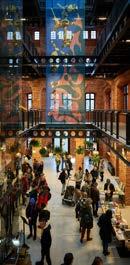
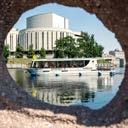


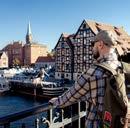
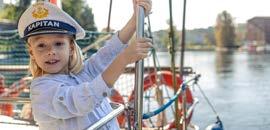


Gdańsk Old Town
A unique blend of Germanic and Central European medieval architecture, gilded by the wealth of maritime trade, Gdańsk’s historical centre is one of the largest and most unique in all of Europe. Begin here.
Igielnicka Browarna
Mniszki Stolarska feRaksratke
K a r lem i kc a Korzenna
Lawendowa anaimołS Strag an iarska Grobla III U ytruF
Szklary Grobla II
Krowia alborG I Złotników Szeroka
azselK
Korzenna aksrakytkeL Piwna aizoK Kołodziejska LatarnianaaksralgęW M a r i
Młyńska aksńaP Podmłyńska
Garncarska Na Piaskach Kowalska iBleńaks a Podbielańska
Elżbietańska
Garbary wókinwodołS Za Murami awotzcoP Długa azcintelaK Ogarna aksńazczseiM azcinwaŁ aksramarK Chlebn icka
Walking Tour
This self-guided sightseeing route links the most important and interesting sites in the very centre of Gdańsk. From the train station, take the tram one stop south to 'Brama Wyżynna' (B-6) to begin the route like a king, or hop on and off the tour as desired. Roughly 4.7km, strolling its entirety could take you 1-5hrs, depending how you use your time. To help you out, we’ve listed the approximate visiting time of each museum along the route, and you’ll find our recommendations for where to take a rest and refuel on p.54. If you’re in Gdańsk for just 1 day, this is how you should spend it.
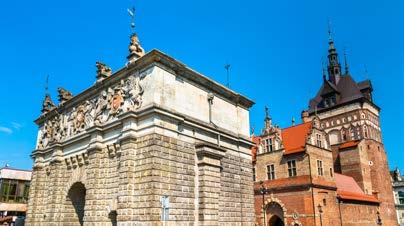
Upland Gate
Welcome to the entry point of Gdańsk's so-called 'Royal Way.' Built in Mannerist style in the 16th century, it was outside this main gate that visiting monarchs were feted and given the keys to the city, before parading down ul. Długa. Originally part of Gdańsk's defensive ramparts, the gate was originally accessed via a drawbridge over a 50m moat. Today it hosts a handy tourist information office. See if you can identify the coats of arms of Poland, Prussia and Gdańsk on the western facade.
B-6, Wały Jagiellońskie 2A.
Foregate Complex
Between the Upland and Golden gates lies the 16th-century 'Foregate' complex which long ago functioned as a courthouse, prison and torture chamber. Pass through the courtyard, where you'll see stocks and a grate behind the door which was allegedly used to flood the underground cell to the extreme discomfort of those within. In summer, admission gets you access to two small exhibits and panoramic views from the prison tower, if you're up for the climb (interiors closed in winter).
B-6, Targ Węglowy 26.
The Upland Gate (left) and Foregate Complex (right). Photo by Leonid Andronov / AdobeStock.
Golden Gate
Built between 1642-44, numerous allegorical statues adorn the balustrade overlooking ul. Długa, and an inscription on the gate reads, “Small states grow by concord, great ones fall by disagreement.” Proceeding through, you are now on ul. Długa (Long Street) - the heart of Gdańsk's Old Town.
B-6, ul. Długa.
Choose Your Adventure!
Continue in royal fashion down ul. Długa towards the Town Hall (#4)?
Make a side trip south down ul. Garbary to see more of the city's defensive towers en route to the Shakespeare Theatre?
Main Town Hall
Soaring above Gdańsk’s high street, the city’s magnificent and iconic Town Hall was originally built in the 14th century and painstakingly repaired following World War II. Today the building is accessible as a branch of the Museum of Gdańsk and houses one of the most beautiful Renaissance halls in Northern Europe, plus several halls full of lavish paintings, furnishings and a huge collection of silver. On the top floor is an exhibit about what everyday life was like in Gdansk right before the war, and, in the warmer months, you can ascend to the top of the 80m tower for fantastic views (Open MaySept only). Visiting time: 75mins.
C-6, ul. Długa 46/47. Open hours vary - Check muzeumgdanska.pl. Admission 25/18zł, Mon free.
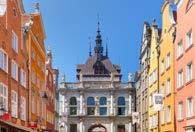
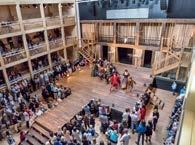
The Gdańsk Shakespeare Theatre
It is widely recognised that Gdańsk was visited by itinerant English acting troupes each summer from about 1600 onwards, performing at a theatre called The Fencing School that may have been modelled on the Fortune Playhouse in London. The Fencing School was demolished and replaced by the Komedienhaus in 1740 where performances were given until the start of the 19th century. The city has spent a lot of money and energy reviving this tradition in recent years, culminating in the 2014 opening of the remarkable Shakespearean Theatre on the site of the old Fencing School. This impressive construction can be adapted for different types of staging and even open its roof for daylight performances. The audience watches from seating in front of the stage or on cushioned benches around the sides designed like the viewing areas in an Elizabethan theatre. The theatre organises performances in many languages and plays host to festivals, exhibitions, film screenings, workshops and more - Check teatrszekspirowski.pl the program, you can take a 1hr tour (35/30zl) of the impressive building and learn about its 17thcentury origins. There is also With Shakespeare at Hand, combining the tour format with performance (1.5hrs, 40/30zl)
B-6, ul. W. Bogusławskiego 1. Box office open 14:0019:00. Performances 30-200zł.
View of the Golden Gate and the Foregate Complex from Długi Targ.
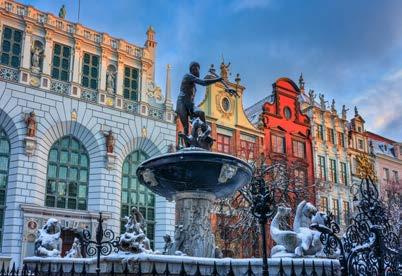
Neptune Fountain & Artus Court
Here, in the very centre of The Royal Way, ul. Długa becomes Długi Targ (Long Market) - so named because its unique shape, which differs greatly from the ‘squares’ of most European cities. In the middle of this narrow, continuous strip is the famous Neptune Fountain, first erected in 1549. During WWII, the fountain was spared from destruction, as it was taken apart and hidden away with other local treasures. Neptune finally returned to his post in 1954 and today is one of the city’s most iconic and photographed landmarks.
The colourful and ornate houses on either side of Długi Targ used to be home to Gdańsk’s richest, most elite residents. The most notable piece of real estate here is at number 44 - the white-arched Artus Court. Founded as a meeting place for merchants and dignitaries, it was named after the original ‘round table talks’ guy, Britain’s King Arthur, and remains a symbol of the city’s power in the 16th and 17th centuries. Following a fire
in 1841, it was renovated into a more Gothic form, complete with ostentatious sculptures and paintings illustrating man’s merits and vices. Today a branch of the Museum of Gdańsk, its beautiful interior furnishings and art are worth a visit. Visiting time: 30mins.
C-6, ul. Długi Targ 43/44. Open hours vary - Check muzeumgdanska.pl. Admission 23/16zł, Mon free.
Fahrenheit Monument
An important name and instrument in science! Daniel Fahrenheit (1686–1736), the physicist and inventor, was born just a block away from this recreation of his ‘Mercury in Glass’ thermometer and barometer. Though he was the first to invent the mercury thermometer in 1714, this particular example, as the plaque below notes, was modelled on his improved model from 1752.
C-6, ul. Mieszczańska.
Naked Neptune always says "It's forkin' freezing!" when Winter hits Gdańsk.
Green Gate
Congratulations! You have just completed ‘The Royal Way’. If you were a Polish monarch, you would have taken up quarters in this fourarched not-particularly-green gatehouse on the waterfront. Lech Wałęsa (p.57), a much later Polish head-of-state, also had his office here before moving to the European Solidarity Centre (p.59). Following careful renovation, the gate now bears an uncanny resemblance to Amsterdam’s central train station, and you can enter for a visit to the Gdańsk Photography Gallery - a small branch of the National Museum. Visiting time: 1hr.
D-6, ul. Długi Targ 24. Open 10:00-17:00; Mon closed. Admission 20/12zł. Students 7-26 years old 1zł
Mariacka Street
Unlike other reconstructed streets in the Old Town, Mariacka was pieced back together after WWII with salvaged materials and debris, resulting in arguably the most picturesque lane in Gdańsk today. Among the most iconic relics are the ornate stone rain gutters on the tenement terraces, known locally as Rzygacze ('Spewers').
Many consider Gdańsk to be ‘The Capital of Amber,’ and Mariacka is the place to buy it in Poland. Rather than a chintzy market or shopping mall, the street is subtly lined with the country’s most knowledgeable and respected amber dealers and craftsmen.


Piwnica Rajców is a restaurant located in the heart of Gdańsk, within the cellars of the historic Artus Court. Our beer, brewed on-site, has been highly acclaimed by Poland's prestigious Craft Beer Competition. Polish cuisine dominates our menu, with other dishes inspired by Mediterranean cuisine to complement.
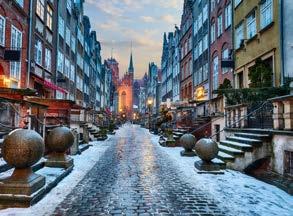

Mariacka Street - Amber and a great photo opportunity!
St. Mary’s Basilica
The most visible landmark on the city’s skyline, St. Mary’s is believed to be the largest brick church in the world, with an estimated 1 million in its structure. Built between 1379 and 1502, it was initially a place of worship for both Catholics and Lutherans, then became exclusively Lutheran (15261945), and then Catholic after WWII. The church can hold up to 25,000 people, which was useful during the period of martial law (1981-1983) when members of the Solidarity movement (p.57) sought refuge here. Damaged in WWII, the original frescoes have sadly been whitewashed, but this brings out the wealth of other treasures inside. The most notable of these is the astronomical clock dating from 1464, with a complex dial showing the time, date, zodiac, phases of the moon, position of the sun, and featuring a procession of wooden apostles chased by Death as Adam and Eve ring the hour - see
it in action every day at exactly 11:57. You can also climb the 405 steps of the 78m tower, which houses a viewing platform with splendid views of old Gdańsk. C-6, ul. Podkramarska 5. Open 08:30-17:30; Sun 11:0012:00 and 13:00-17:00, Viewing tower open 10:00-18:00; Viewing tower admission 18/10zł
Choose Your Adventure!
Have a peek at one of Gdańsk’s most grandiose architectural monuments by carrying on to the Great Armoury at #10?
Hasten your pace to #15 (and perhaps onward to the Amber Museum (#12) by taking one of the sidestreets between ul. Mariacka and ul. Św. Ducha?

St. Mary’s Basilica: more bricks than Shaq at the free-throw line.

The Great Armoury
Built from 1600-09 on the line of the former medieval city walls, this was a working arsenal until the 1800s, and remains the finest example of Renaissance architecture in the city. The welllike structure in front was used as an elevator to transport gunpowder and cannon balls from their storage place in the basement to ground level. The armoury was badly damaged in WWII and had to be completely rebuilt. It’s only in recent years that it has regained its former glory, following a spell during which it even played host to a supermarket. It’s now open as an art gallery, hosted by the Gdańsk Academy Of Fine Arts, with a classy wine bar on the ground floor, which gives you a chance to take a look inside when there are no exhibitions. See if you can spot the randy lion on the facade. B-5, Targ Węglowy 6. Open hours vary - Check zbrojowniasztuki.pl.
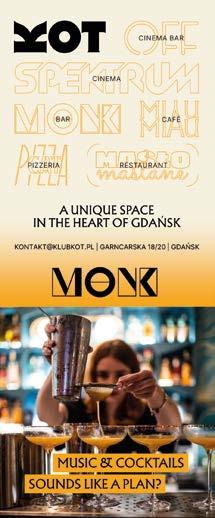
The Great Armoury seek-and-find: 1 pent up lion.

Gdańsk Market Hall
One of the city’s more uniquelooking buildings, Gdańsk’s Hala Targowa (Market Hall) was built in 1896 in Neo-Gothic style. Inside and out you can find just about anything imaginable on sale, particularly cheap clothing, fresh flowers, produce, fruit, meat, dairy and more. During recent renovations, the foundations of one of the city’s oldest churches, the 12th century Church of St. Nicolas, were discovered underneath the main market building and today there is a small, living
archaeology museum - known as the Romanesque Cellars - in the basement, along with a display of photographs, objects found during the excavations and drawings of how the church might have looked; you’ll find the entrance in the outdoor part of the market (Open 10:00-17:00, closed Mon; Admission 10/7zł, kids under 16 1zł, under 7 free, Sun free; visiting time 30mins).
C-5, Plac Dominikański 1. Open 8:00-18:00; Sat 8:00-15:00; closed Sun.
The impressive neo-gothic facade of the Gdańsk Market Hall.
Amber Museum
Housed in Wielki Młyn (The Grand Mill), a building that once processed the grains that provided renaissance Gdańsk with its wealth, the Amber Museum is one of the city’s most modern cultural attractions. Within its ambient-lit interior, you are taken on a multimedia journey through the multi-million-year history of Baltic amber, followed by a multitude of exhibits, where you’re able to get up close and personal with amber from all over the world. The impressive collection of “inclusions” (when bugs or plants are caught inside the amber) is intriguing to look at, and the many amber creations, from inkwells to spoons to a stunning Fender Stratocaster guitar, shows the material’s diversity. There are also a number of masterpieces by the old masters of Gdańsk, plus a collection of modern artworks and jewellery.
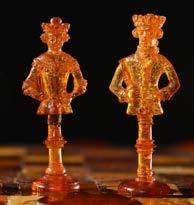
DNA
scientists
Make sure you also check out the grounds around the Grand Mill, which includes the picturesque white Miller’s House, a padlock-lovers bridge with a killer view, and the statue of Jan Heweliusz (Johannes Hevelius), the astronomer and Gdańsk local who financed his scientific career through beer brewing! Visiting time: 2hrs.
C-4, ul. Wielkie Młyny 16. Open hours vary - Check muzeumgdanska.pl. Admission 35/25zł, Mon free.


GRASS SPORTS BAR GDANSK IS THE PLACE WHERE ANY WITHOUT EXCEPTION WILL FEEL GOOD
LIVE MATCH - PREMIER LEAUGE, CHAMPIONS LEAGUE, RUGBY, ICE HOCKEY, ELITESERIEN, ALLSVENSKAN, GUINNESS AND GREAT FUN!
Szeroka Street 121/122, Gdansk
+48 58 322 10 14
grassrestaurant.com
Using
preserved in these amber chesspieces,
are cloning a chesspiece army!
St. Catherine’s Church
This 14th-century brick church is closely connected with famous astronomer and brewer Jan Hevelius (1611-87). Known as the 'Polish da Vinci’ and ‘founder of lunar topography,’ Hevelius also served as the city’s mayor, as well as the administrator of this church, which is his final resting place. You’ll find his tomb at the rear behind the altar. Rather spartan inside, the most interesting part of the church is its tower, which hosts a small museum dedicated to tower clock mechanisms (Open May to September). The exhibit takes you all the way back to the 15th century, when time-keeping may not have been as efficient but it was certainly more beautiful to watch. St. Catherine’s 76m tower is also home to a 49-bell carillon - one of only 3 in Poland and in summer the views are worth climbing the 258 steps to the top. Visiting time: 30mins.
C-4, ul. Profesorska 3. Church open 6:30-18:30; no visiting during mass. Museum open hours vary - Check muzeumgdanska.pl.
St. Bridget’s Church
If you haven’t seen enough amber already, pop into St. Bridget’s to see its famous amber altar. Although still a work in progress, the altar apparently already contains more amber than St. Petersburg’s legendary Amber Room. If that’s true - and who can verify? - it kind of takes the shine off the legend in our opinion, but this is still an impressive project. Dating back to the late-14th century, St. Bridget’s was destroyed in WWII and rebuilt to its medieval design in 1973. It soon became the favoured church of the leaders of the Solidarity movement. In fact, St. Bridget’s controversial priest Father Henryk Jankowski held masses in the shipyards during the srikes of 1980, and was a vocal critic of the communist regime in his role as Solidarity’s chaplain. The church is also home to a number of historical shrines and a spooky crypt.
C-4, ul. Profesorska 17. Open 10:00-18:30; Sun 13:3018:30. Admission 6/3zł.

The Royal Chapel and lions of Four Quarters Fountain.
Choose Your Adventure!
Follow the prescribed route south - back towards the centre of the Old Town?
Head east on ul. Zamkowa towards the infamous Polish Post Office (p.33) to learn its tragic history?
15
Royal Chapel
Often overlooked because of its gargantuan neighbour, this little baroque beauty was built in the late 17th century, at a time when the majority of Gdańsk and Northern Poland residents were Protestant (even the mighty St. Mary’s Basilica was a place of Protestant worship at the time!). Thus, the Royal Chapel, funded in part by King Jan III Sobieski, was built to serve the city’s Catholic minority. The most eye-catching building on ul. Swiętego Ducha is also perhaps overshadowed by the popular Four Quarters Fountain just across the road, which features four life-sized lions - the ancient symbol and protectors of Gdańsk - and 24 streaming jets of water (in summer). Although the Royal Chapel is officially closed to visitors, it is still open to those attending mass (please dry yourself off first).
C-5, ul. Św. Ducha 58. Open during mass - Weekdays 08:3017:30; Sun and Festivity Days 11:00-12:00, 13:00-17:30
16
Św. Ducha Footbridge
Opened in 2020, thus bridge has a fixed base running parallel to the riverbank on which the bridge rests when closed for pedestrians so that boats may pass through; the bridge then pivots 90 degrees to allow pedestrians to cross. When it's 'closed', it looks like a half submerged submarine. From April-Oct the bridge rotates every 30mins between 9:00 and 20:00, staying open for pedestrians overnight. From Nov-March it is open for pedestrians 24hrs/day, except when vessels request to get through. If your timing’s good you can take this shortcut over to Granary Island and refuel in one of the many gastro spots on the opposite side; otherwise, you’ll have to wait, or carry on along the west bank.
D-6, Długie Pobrzeże 23.
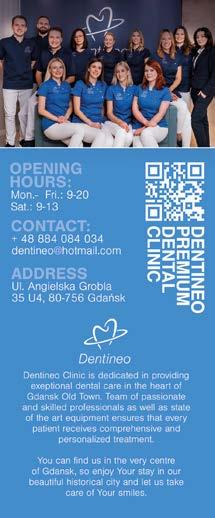

Due to ongoing construction works, the northward waterfront route may be closed. If so, backtrack on ul. Świętego Ducha and follow the alternative path on parallel side-streets (see map - p.39).
The Crane
One of the defining symbols of Gdańsk, the iconic Żuraw (Crane) represents what little is left of the city’s great trading age. First mentioned in 1367 and most likely constructed from wood in its first iteration, the current structure dates from around 1444. At one time this was the biggest working crane in the world, used for cargo transfer, putting up masts on ships, as well as doubling as a city gate. The crane’s lifting mechanism was powered by men walking inside of the large hamster-wheels at its base. 80% destroyed at the close of WWII, it has since been reconstructed and is now a branch of the Maritime Museum. The exhibition inside recreates the city's 17th-Century 'Golden Age', with its content focusing on the structure's operation, shipping, and a tavern rowdy renaissance tavern.
D-5, ul. Szeroka 67/68. Open 9:00-17:00; Wed 13:0017:00; closed Mon. Admission 23/17zł. Wed free. Tickets available from the Maritime Cultural Centre next door.
Trader’s Gate
Built between 1481 and 1492, this brick beauty comes crowned with two turrets. Its most unique feature, however, here is a heraldic coat of arms seated over the entrance, bearing the emblems of Gdańsk, Prussia and Poland taking centre bow. Almost completely destroyed at the tail end of WWII, this Gothic-style gate was reconstructed using an 18th-century painting as a reference for its design. This decision reflected the policy of the post-war Polish government, who wanted to return their ruined cities to a pre-1772 look ie. before the influence of foreign occupation.
D-5, ul. Straganiarska 37.
Targ Rybny
This historical landmark and public space was the site of Gdańsk’s fish market from 1343 until World War II. It was established by the Teutonic knights, whose castle stood nearby from 1308 to 1454 when it was dismantled by the residents of Gdańsk immediately after being abandoned. The fish market continued, however, and was separated from the river by and wall and two city gates
Targ Rybny - Gdańsk’s old fish market, and Swan Tower.
from the 15th century onwards. Damaged beyond salvation during the war, along with the adjacent waterfront houses, the only remnants of these defensive walls today is the Swan Tower (Baszta Łabędź), which currently houses the Polish Maritime Club. The fish market’s pre-war function never returned and today it is the most open space on this side of the river, hosting occasional fairs and events. It also features the colourful Gdańsk Carousel, which offers expensive rides from well-behaved horses.
D-4/5, Targ Rybny.
Choose Your Adventure!
Continue over the drawbridge (#20) and along the prescribed route?
Keep following this side of the river to reach the WWII Museum (p.32)?
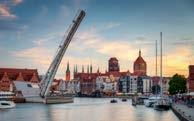
20
Ołowianka Drawbridge
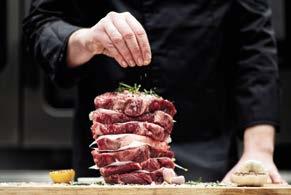

Another modern engineering marvel over the Motława, this much-needed footbridge connecting the Old Town near Targ Rybny to Ołowianka Island opened in 2017. Prior to that it was a real pain to get across the river during the roughly 10 months of the year when it wasn’t frozen solid. Similar to the Św. Ducha bridge, this pedestrian bridge is actually a drawbridge that raises straight up in the air from the Ołowianka side to let boats through. From November 1 to March 31 - the footbridge is open to pedestrians at all times, except when requested by water-bound vessels. On the other side you’ll find the ‘Gdańsk’ marque sign that serves as social media bait, and the huge ‘Amber Eye’ Ferris wheel | D-4.



Polish Baltic Philharmonic
You’re now on Ołowianka Island, which takes its name from the Polish word ‘ołów’ (lead) due to the fact that lead metals, sailed upriver from Silesia, were stored here in medieval times. Later, these warehouses were used as granaries, several of which now house the Martime Museum (#22). The massive neo-gothic redbrick building of the Philharmonic was built at the end of the 19th century and housed the city’s hydroelectric power plant until its closure in 1996. Converted into a pristine acoustic space, it reopened as the home of the Baltic Philharmonic in 2005, with a program full of events. Consider attending a concert there!
D-5, ul. Ołowianka 1. Check filharmonia.gda.pl for program.
Maritime Museum & ‘Sołdek’ Steamship
The National Maritime Museum is one of Gdańsk’s biggest cultural institutions, with nine total branches around Pomerania, four of which are all concentrated in close proximity between The Crane and Ołowianka Island. The largest and most comprehensive of these is located here inside three Renaissance granaries. A complete history of Poland’s nautical history is represented via old cannons, huge oil paintings, harpoon guns, hard hats from the Lenin Shipyard, an extensive collection of model ships and more. Moored just outside you’ll find ‘Sołdek’ - the first
steamship built in the Gdańsk Shipyards after 1945. An ore collier before retiring to become a seasonal museum ship (closed until mid January as well as during adverse weather conditions), just about every inch can be accessed - from the cramped engine room to the bridge to the pokey little cabins the crews lived in. The opening hours of the Martime Museum are too complex to include here, as are the ticketing packages, which is why we recommend checking their website. Visiting time: 1hr each.
D-5, ul. Ołowianka 9-13. Open hours vary - Check nmm.pl. Joint tickets 39/29zł to 75/56zł depending on how many museum branches are included.
Stągiewna Gate
Stągiew is Polish for ‘Milk Can’ and the gate is shaped like that, hence the name ‘Stągiewna Gate.’ This 16th-century fortification once guarded the entry to ‘Granary Island’, where the city’s renaissance grain industry was most prevalent. By 1643, there were 315 granaries on the island capable of storing up to 250,000 tons of grain and servicing over 200 ships. After being completely levelled at the end of WWII, the island remained untouched for 60 years. In the last decade, however, Granary Island has been revitalised into a thriving gastro district.
D-6, ul. Stągiewna.
Waterfront view of the ‘Sołdek’ steamship and medieval Crane (p.50).
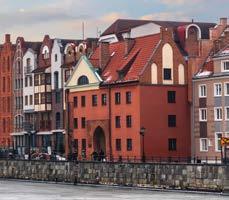
24
Green Bridge
We finish our adventure around Gdańsk at the Green Bridge, which connects Granary Island to the centre of the Old Town. What used to be a drawbridge that would be raised to keep the riff raff out of the prestigious centre is now open to you and the public to travel through as you please. Enjoy the picture-perfect view of the Motława, grab a bite to eat on either side of the river, or continue exploring!
D-6, ul. Stągiewna.
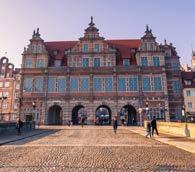
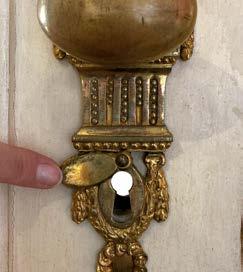
Congrats, we've come full circle back to the not-so-Green Gate!
OLD TOWN
Eat & Drink
When it comes to travel these days, gastronomy is almost as important as sightseeing and culture. Below we list some of our favourite venues near the Walking Tour route. For full details, directions and additional recommendations, visit our website.
COFFEE & BREAKFAST
Leń
C-6, ul. Piwna 52/53
Marked by a flamingo out front, this cozy and youthful operation stocks a variety of roasts to choose from, along with all the latest brewing methods and gorgeous cakes!
0
Bistro Młyn
D-7, ul. Pszenna 5
The absolutely divine breakfast menu of this colourful Granary Island restaurant has earned it a devoted following. Stop in to see what the fuss is about.
012
CASUAL DINING
Brovarnia
D-6, ul. Szafarnia 9
Delicious Polish cuisine and the best beer that can be found in Poland is right here within the oldest-operating brewery in Gdańsk.
128
Forza
C-5, ul. Szeroka 121/122
Napoletana Canotto-style pizza and fresh pasta, put into action by authentic Italian products and recipes, with pistachios and fresh truffles to complement!
24
Masło Maślane
B-5, ul. Garncarska 18/20
This resident of the historic club ‘KOT’ sees traditional Polish recipes reimagined with a modern twist, and served to share the moment!
125 Piwnica Rajców
C-6, ul. Długi Targ 44
Gdańsk’s historic councillors' cellar is now a quality restaurant with a comprehensive menu, and they brew their own beer on-site!
2845
Słony Spichlerz
D-5, ul. Chmielna 10-11
This waterfront social hub and indoor food hall features a diverse range of dining options, weekend brunch, and it stays open late.
284
Woosabi
D-6, ul. Chmielna 10
A wonderfully diverse menu of Asian-fusion cuisine - rice bowls, noodles, bao buns and the likeserved up in a lush tropical interior.
24
FINE DINING
Thai Thai
B-4, ul. Podgarbary 10
Located in the historic Royal Stables building, our long-time favourite Thai restaurant is a rather classy affair with even classier food.
65
True Restaurant
D-5, ul. Chmielna 10
Enjoy the flavour fusions and riverside views from the sunlit terrace of this upscale and exotic surf & turf restaurant on Granary Island.
65 BARS
Pijalnia Wódki i Piwa
C-6, ul. Długi Targ 35/38
Gdańsk’s ‘snacks & shots’ bar, furnished and stocked to create the look and feel of a typical communist-era drinking establishment. Open late!
254
Browar PG4
A-3, ul. Podwale Grodzkie 4, Gdańsk
A microbrewery/restaurant in a historic red brick building offering 6 house beers, cocktails, and a menu of scrumptious, seasonal cuisine!
284
Flisak ‘76
C-6, ul. Chlebnicka 9/10
Fancy a cocktail? Descend the stairs into Flisak’s slick subterranean pad, featuring a phenomenal drinks menu skillfully concocted by award-winning mixologists!
4
Monk
B-5, ul. Garncarska 18/20
Reviving the Avant-Garde '60s spirit of its host premises, Monk is the perfect combination of live music and a repertoire of colourful cocktails!
453
LATE NIGHT
Bunkier Klubogaleria
C-4, ul. Olejarna 3
A huge, reinforced concrete WWII bunker, now hosting one of Poland's most visually stunning clubs.
2437
SASSY
& Roof Top by SASSY
D-7, ul. Chmielna 10
This classy 8th-floor perch on the Old Town waterfront seamlessly blends top-quality Asian cuisine with a cosmopolitan art and entertainment experience.
284573
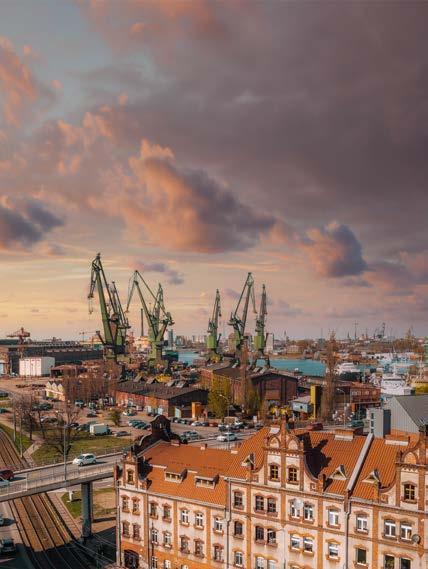
Gdańsk Stocznia
Although they flourished during the late-19th century, the Gdańsk Shipyards are best known today as the birthplace of Solidarity - the social movement that began here in 1980, and ultimately ended communist rule in Poland. Largely abandoned amidst declining industry, the Shipyards are slowly being revived into an alternative centre of culture, gastronomy and nightlife.
Photo
The Story of Solidarity
NSZZ Solidarność, known in English as ‘Solidarity,’ is a still-functioning Polish trade union. It was founded in August 1980 at the Lenin Shipyard in Gdańsk Stocznia. At the time, Poland had been under communist rule since the end of WWII, and living conditions were unbearable. While there had been civilian unrest in the 1950s and ‘70s, all of it brutally crushed, it was the firing of Anna Walentynowicz in August 1980, that motivated shipyard workers to go on strike yet again. Lech Wałęsa, an electrician who had been fired in 1976, was one of the strike’s instigators, and, after famously scaling the shipyard wall, he became a key leader. As strikes gained momentum across the country, Wałęsa and other labour leaders saw the opportunity to create a trade union movement to represent Polish workers and fight injustice. Instead of confronting the communist authorities, the strikers locked themselves inside the shipyards and, after 3 days, presented 21 demands on placards that hung on Gate No. 2.
On August 31, the government backed down and agreed to meet their demands, thereby marking the first-ever peaceful victory over communism
In the months following, some 10 million people joined the Solidarity movement, and Poles enjoyed a freedom unknown for decades, until the government declared martial law on December 13, 1981 in an attempt to reassert authority. Solidarity was officially dissolved, and Wałęsa and other leaders were imprisoned. The trade union continued to operate underground, however, and a renewed bout of labour strikes forced communist leader Wojciech Jaruzelski into talks with opposition figures in 1988. The following year Solidarity was once again granted legal status. Participating in Poland’s first post-communist election, Solidarity swept to victory, and Wałęsa became the first freely-elected president of Poland in 1990. Today, Solidarity is internationally recognised as the catalyst for the chain of events that ultimately led to the dissolution of the Soviet Union in late 1991.
Plac Solidarności Brama Oliwska
Walking Tour
Featuring one of Gdańsk's most essential museums, plenty of fascinating labour history and industrial heritage sites, and a growing number of hip alternative hangouts, Stocznia’s compact space makes it very easy to explore. Our walking route only covers 2km, but you can easily spend a day here if you’re committed to visiting ECS (#3) and learning the history. Begin by catching tram 7, 8 or 10 to Plac Solidarnośći, or do the tour in reverse by starting at ‘Gdańsk Stocznia’ train station.

Monument to the Fallen Shipyard Workers of 1970
In December 1970, riots erupted in the streets of Gdańsk and Gdynia in response to a sudden increase in prices for food and everyday items. Stemming from a general strike in the shipyards, the communist regime responded to the protests with brute force and 45 people were killed. Later, in 1980, one of the Solidarity trade union’s 21 demands was for this memorial to be erected in their honour. Standing 42 metres high, the 139-tonne steel sculpture was erected on the spot where the first three victims of the 1970 riots were killed, and includes a soaring
cross for each victim - each with an anchor on itwhile at the bottom their struggling comrades are depicted. A poignant inscription by Czesław Miłosz reads, ‘You who have harmed simple man, mocking him with your laughter, you kill him, someone else will be born, and your deeds and words will be written down.’ Solidarity leader Lech Wałęsa had his own poetic moment with the monument, referring to it as ‘a harpoon driven through the body of a whale. No matter how hard the whale struggles, it can never get rid of it.'
B-2, Plac Solidarności.
Shipyard Monument and historic Gate #2. Photo by Patryk Kosmider, Adobe Stock.
Gate #2 of the Gdańsk Shipyard
On August 31, 1980, when a deal had been struck with the Polish communist government, Lech Wałęsa stood upon this gate to announce the news to the crowds waiting outside the shipyard. Listed as a historical monument, the gate remains decked in flowers and photos of Polish-born Pope John Paul II, who visited his homeland in 1979 and openly encouraged his compatriots to demand political change. This is also where the original 21 demands hung for public view, and you can see a faded copy hanging in its place. | C-2, ul. Doki 1.
European Solidarity Centre (ECS)
This award-winning 5-storey facility was designed to resemble a rusty ship hull - a nod to local industry, and a clever metaphor for the communist system. Awarded the European Heritage Label along with its surrounding sights, ECS is free to enter and includes a museum (not free), several conference halls, library archives, a roof-top terrace with great views of the surrounding shipyards (free), and a supervised play area for kids (not free). The museum's huge permanent exhibit combines traditional display methods with some truly impressive state-of-the-art technology, presenting the story of Solidarity along with the social/cultural context of Poland at the time; grab an audioguide to get the most out it. One of the Tri-city’s most important cultural centres, make time for this one. Visiting time: 2-3 hours.
C-2, Plac Solidarności 1. Open 10:00-17:00; Sat, Sun 10:0018:00; closed Tue. Permanent exhibit 35/30zł (includes audioguide); temporary exhibits 15/10zł; play department 9/5zl, kids under 2 free.
BHP Building
Just metres from the ECS, the shipyard’s Occupational Health & Safety Hall, abbreviated in Polish as Sala BHP, is where the meetings during the August 1980 strikes took place, and where the landmark August Accords (agreeing to meet the 21 demands of the workers) were actually signed. The hall houses a small free exhibition of images and memorabilia from the period when the movement was at its peak. There is also a recreation of the long table where government representatives and
Solidarity leaders signed the historic agreement. Lech Wałęsa famously used a large souvenir pen from the Vatican, thus signing with “the Holy Father’s authority! Visiting time: 45 mins.”
C-2, ul. ks. Jerzego Popiełuszki 6. Open 10:00-18:00.
Admission free.

Shipyard Directorate
Crossing over ul. Popiełuszki, the large redbrick building to your right housed the offices of the shipyard director in both the pre- and post-war periods, and the space in front of it was the shipyard parade ground. The building was famously captured in the background of Stanisław Składanowski’s iconic photograph of Lech Wałęsa being carried shoulderhigh by burly colleagues after successfully negotiating the August Accords. Today it’s been renovated into modern office space with co-working space on the top two levels. | C-2, ul. Doki 1.
Choose Your Adventure!
Head 200m north and ascend the Żuraw M3 crane lookout (C-1) and take in the view?
Head east down ul. Narzędziowców to wander through the largely abandoned Imperial Shipyard? (p.60)
Head west to explore the areas of the Shipyards that have already begun to be revived as a place of alternative urban culture?
Moustaches unite! Wałęsa in 1980. Photo by S. Składanowski.

The Imperial Shipyard
The industry of ship building and maintenance have been a part of Gdańsk since the earliest days of its settlement. However, it was the Imperial Shipyard of Gdańsk that was the foundation of the city's shipyard district as we know it today. The Kingdom of Prussia annexed the city when a weakened Poland was carved up by its neighbours (1772-1795). Thus, Gdańsk (or Danzig) became the centre of Prussian (and later German) naval infrastructure. This shipyard operation would be founded in 1844, centred in the area that now runs the length of ul. Narzędziowców. By the start of WWI, the Kaiserliche Werft (The Imperial Shipyard) had become the largest shipyard in Europe.
This historic area has only recently been opened to the public as a self-guided walking tour. Among the many sights here are the Żuraw M3 crane (C-1), which operates as a panoramic lookout (Open Sat, Sun 10:00-18:00), the locksmith building and dock basin that still buzzes with activity, and various temporary and permanent modern art spaces that inhabit many of the repurposed industrial lots.
NOMUS - New Art Museum
A contemporary art gallery located in the former shipyard school building. Visiting time: 1hr.
B-1, ul. Stefana Jaracza 14, tel. (+48) 517 612 148, www. nomus.gda.pl. Open 11:00-18:00; closed Mon. Admission 15/8zł, students 1zł, kids under 7 free, Fri free.
WL4 Art Space
An artists' squat/workshop and exhibition space, located in the former shipyard furniture warehouse. Visiting time: 1hr.
ul. Doki 68, Open Sat, Sun 12:00-15:00; www.wl4.pl Check online for exhibition prices and extended hours
Elektryków Street
Elektryków (Electricians’ Street) references one of the many professions held in the glory years of the Gdańsk Shipyards, not to mention the original trade of the man himself, Lech Wałęsa. Although the democratic change Wałęsa fought for was undoubtedly a good thing for Poland, capitalism and the free market proved to be a double-edged sword for the shipyard industry, and its privatisation saw the work move elsewhere in Europe. For many years this shipyard block was practically a ghost town, but a younger generation has begun to adapt these old industrial spaces for contemporary food and culture concepts. Today Elektryków's old buildings are full of art galleries and studios, hip shops and secondhand stores, restaurants, bars, clubs and concert spaces, with the action flooding outdoors during the warmer months. Whilst activities are notably muted between October and April, we recommend checking online for live music events at concert venues B90 and Drizzly Grizzly! | B-1.

Elektryków’s B90 club is still an active concert venue in winter.
NOMUS - New Art Museum

7
Stolarzy Street
Along with Elektryków, this is the contemporary heart Stocznia's current incarnation as a headquarters for street art, street food, urban sounds and DIY culture. In summer, the outdoor area around Stolarzy is an absolute hipster playground - most of it made out of shipping containers, filled with food trucks, bars and deckchairs. Unfortunately, during Winter, access to the popular 100cznia container bar area is not possible, as is the LayUp urban art gallery (Open May to September). For all the like-minded gastro and cultural happenings at this time, head over to Montownia Food Hall (See Eat & Drink). | B-1.
8
Gdańsk Shipyard Cranes
Ascending the footbridge that leads over to the Gdańsk Stocznia SKM station (Closed until 20 January 2025), here you have the perfect vantage point of the iconic cranes of the Gdańsk Shipyards. Imported from Finland in the 1970s, each of these mighty green structures was capable of lifting 150 tonnes, and were, of course, used in the construction of ships. Today, these cranes are a lasting connection to the age of shipbuilding in Gdańsk and the glory days of Solidarity.
Once you’ve taken a snap of the view, you can hop on the SKM train (or tram) and head south to Gdańsk Główny (B-4), or north towards Sopot (p.74) and Gdynia (p.82). | A-1.
STOCZNIA Eat & Drink
Derelict not long ago, Stocznia is slowly being revitalised into a unique alternative to the antiquated Old Town, with contemporary gastro concepts and event venues that suit its unique industrial spaces. Although winter is considerably less lively, the venues listed below are active yearround and a weekend visit may lead to more surprises.
Bar '80dziesiątka'
C-1, Plac Dyrekcyjny
In operation and essentially unchanged since 1980, drop into this small shipyard workers lunch bar for a cheap hot meal, cheeky drink or just a look at the PRL-era decor. Closes at 15:00.
2
Montownia Food Hall
C-2, ul. Lisia Grobla 7
Gdańsk’s historic WWII-era U-boat hall has been adapted into loft apartments with this lively indoor restaurant market on the ground floor, including bars, a performance space, and regular events (check online).
285037
Mielżyński Wines Spirits Specialities
C-1, ul. Narzędziowców 31
Poland’s celebrity wine importer has set up shop in the former shipyard fire station, with an ambient wine bar on the ground floor, and a fabulous restaurant and summer upstairs. A bit of distinction in the midst of dereliction.
Gdańsk's iconic shipyard cranes.

Gdańsk Wrzeszcz
Two SKM stops/4km north of the Old Town, Wrzeszcz began as an 18th-century housing estate and was featured in the writings of German novelist Günter Grass, who lived here in the 1920s and ‘30s. Neglected for decades, recent investment has turned it into one of Gdańsk’s liveliest areas, full of bars, restaurants and shopping malls. Also home to Gdańsk University, head here to escape the tourists and connect with locals.
Browar Gdański Mural at the top of ul. Wajdeloty in Wrzeszcz.
Walking Tour
Beginning at Gdańsk Wrzeszcz train station, our walking tour leads you in a loop around Wrzeszcz’s most historic neighbourhood, before taking you east to Garnizon - a former military zone turned trendy gastronomy area. The tour covers 2.8km and takes about 35mins to complete.
1 Browar Gdański Mural
Representing a long-gone piece of local history, Browar Gdański (The Gdańsk Brewery) began in the 18th century as a small wooden brewery that once stood in nearby Park Kuźnicki. By the mid-19th century it had grown considerably, and was eventually acquired by the Danziger Aktien-Bierbrauerei in 1871. The modern complex which is depicted in this mural was built in the land just north of the
park in 1873. Dominating both the landscape and Prussian beer market, producing 6 million litres of beer a year, Günter Grass spoke of the site in great detail in his third book of the Danzig Trilogy, Dog Years . In 2006, after a gradual decline in post-communist Poland, the complex was sold to property developers and converted into apartment buildings.
G-4, ul. Biała 14.
Gdansk Wrzeszcz
Park de Gaulle'a

Dwór Kuźniczki
The oldest standing building in Wrzeszcz, Kuźniczki Manor (known in German as ‘Kleinhammer’) was built between 1761 and 1763, with the nearby park as part of the estate grounds. After a stint as an inn and an iron forge, it was an interwar theatre venue for the Polish community in what was a German-majority city at that time. Today, it's half-restaurant, half-cosmetology clinic. G-4, ul. Wajdeloty 13.
Wajdeloty Street
The oldest remaining street in the district, Wajdeloty is synonymous with Wrzeszcz in name and character. The charming tenement houses that line it date from the late-19th century, when it was known as 'Marienstrasse.' While everything may look in good now, this was certainly not the case for the 50 years following WWII, when this rundown neighbourhood was known for its decrepit living conditions with shared toilet
facilities. Even famed novelist and former Wrzeszcz resident Günter Grass objected to a statue of himself being erected in the area. Revitalisation began in earnest in 2013, with most buildings renovated and the street returned to cobblestone. Today it's a great area for gastronomy, particularly for vegans and coffeelovers. | G-4/5.
Grass Grocery
Günter Grass was a half-German, halfKashubian-Polish Nobel Prize-winning author, best known for his literary masterpiece The Tin Drum (originally Die Blechtrommel in German). Born in 1924, he was raised in Wrzeszcz (then Langfuhr), when it was part of the German-majority Free City of Danzig. His family owned a grocery shop at this address. Having served in the German military during WWII, a point which would prove controversial in later years, Grass would end up in West Germany, where he studied sculpture and eventually began writing about his childhood home.
Dwór Kuźniczki marks the beginning of what is arguably the nicest, most characteristic part of the neighbourhood.
Upon his death in 2015, Günter Grass, who identified as being Kashubian, was described by Gdańsk Mayor Paweł Adamowicz as someone who ‘bridged the chasm between Germany and Poland.’
F-5, ul. Lelewela 13.
Oskar’s Bench
The Tin Drum tells the story of Oskar, born in 1920s Langfuhr (Wrzeszcz) and mature well beyond his years. He decides to stop growing and uses a small tin drum and a glass-breaking scream to vent his frustrations about lower-middle-class Danzig. Oskar’s character greatly parallels the life of his creator, Günter Grass, and the novel’s mix of cynicism and dark humour is a confronting look at German-Polish relations before, during and after WWII. This Oskar statue was unveiled in 2002, while the statue of Grass joined him in 2015.
F-4, Pl. Wybickiego.
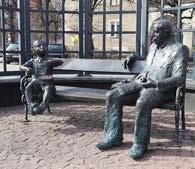
Park Kuźniczki
Formerly part of the Kuźniczki Manor Estate (#2), this park was considerably bigger until the railway line was put through in the 19th century. It then became property of Danziger AktienBierbrauerei (The Gdańsk Brewery), the remnants of which have been incorporated into the modern apartment blocks just to the north. As with ul. Wajdeloty, the park has recently undergone a makeover.
G-4, ul. Kilińskiego.
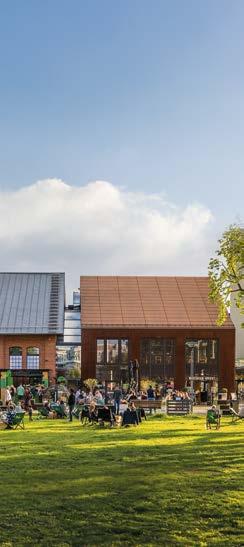
Günter Grass and his precocious creation. Photo by Andrzej Otrębski.
Church of the Sacred Heart of Jesus
Built following a petition raised by the residents of Langfuhr (Wrzeszcz) requesting a Catholic place of worship in the area, this church was consecrated in April 1911. Shortly after his birth in 1924, Günter Grass was christened here by Father Walter Wienke. Two other parish priests from the 1920’s (Franciszek Rogaczewski and Bronisław Komorowski) tragically perished in the death camp at Stutthof (p.93) and were later beatified. The church also had the honour of being visited by Cardinal Wojtyła, the future Pope John Paul II. G-4, ul. ks. Józefa Zator Przytockiego 3. Open 06:0008:30, 18:30-20:00; Sun 07:00-14:00, 18:30-20:00.
Grass Family House
The building where the Grass family lived at the time of Günter’s birth still stands here, though now finds itself isolated somewhat between a bus terminal, a busy road and the Galeria Bałtycka shopping mall.
G-3, ul. Lendziona 5A.
Garnizon
Worth the walk, especially if you’re interested in the latest urban design and gastronomy trends, Garnizon (The Garisson)
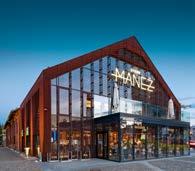
balances out the Wajdeloty café scene with a number of chic post-industrial food and drink options boasting summer gardens full of deckchairs. As the name suggests, this was a closed military zone in the early-20th century, comprised of 10 brick buildings manned by the 2nd Leib-Hussar Regiment. Falling into decline after WWII, a recent rash of investment has filled it with cafes, bars, restaurants, breweries and a stellar concert venue (Stary Maneż). Check out the farmers markets at Gdański Bazar Natury on Thursdays (14:00-18:00) and Saturdays (09:00-15:00).
G-1, ul. Juliusza Słowackiego.

Garnizon’s Stary Manez - a microbrewery and concert venue.
The ‘Bazar Natury’ farmers market, every Thu & Sat in Garnizon.
WRZESZCZ
Eat & Drink
As in most major cities, different districts of Gdańsk have their own unique gastronomy profiles. In Wrzeszcz, which very much caters to the students and young people that live in the area, you’ll find a tonne of cafés, bars and casual dining options, while clubs and upscale restaurants are still in short supply. For more recommendations, visit our website.
COFFEE & BREAKFAST
Avocado SPOT
F-4, ul. Wajdeloty 25
The Nirvana of vegan restaurants in Tri-city, serving a wondrous encyclopediaworth of plant-based cuisine for breakfast, lunch and dinner.
12
Kawana
F-3, ul. Konrada Wallenroda 7
Duck down this side street to discover this creative coffeeroastery, which combines their own stunning graphics with a wide range of imported beans.
0
Norwida 2 Concept
F-1, ul. Norwida 2
Over in the Garnizon end of Wrzeszcz, this specialty-produce store and bakery is well-placed for serving up wholesome breakfasts and energising coffee.
012
CASUAL DINING
Hewelke
G-4, ul. Jana Kilińskiego 7
Drawing inspiration from all corners of the culinary atlas, this imaginative restaurant and bakery aims for the stars with every dish on its sumptuous menu.
284
Limoncello di Mielnik
G-1, ul. Mariana Hemara 15
An exquisite proponent of Italian cuisine, this Garnizon operation serves excellent main courses of meat, fish and seafood, plus original desserts and cocktails.
2480
Stacja Food Hall
G-4, ul. Jana Kilińskiego 4 (Galeria Metropolia)
More than just a food court, this is a young and happening community of eateries and bars, complemented by live music and DJs. Perfect for groups!
2837
NIGHTLIFE
Stary Maneż Browar Vrest
F-1, ul. Słowackiego 23
One of Gdańsk’s premier live music venues (Stary Maneż) combined with a fantastic tapas bar and brewery (Browar Vrest). A valid reason for visiting Wrzeszcz on its own.
283
Graciarnia
G-4, ul. Dmowskiego 15
A brickwork basement hangout, created for lovers of craft beer, boardgames and pub quizzes. Snacks and live music are also a part of the programme.
843
Nowy Browar Gdański
F-4, ul. Jana Kilińskiego 7E
A revitalised part of Wrzeszcz’s historic brewery complex, producing its own beer to complement a fantastic restaurant menu.
128
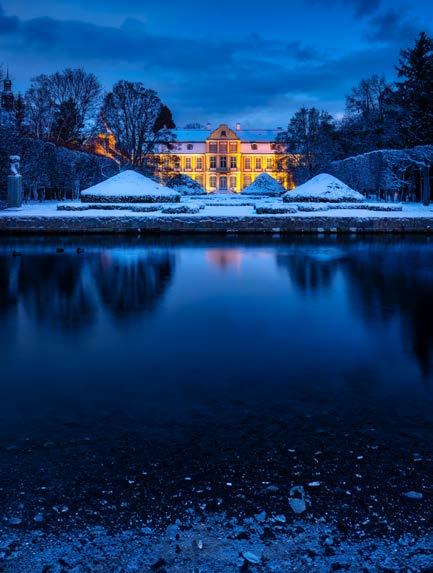
Gdańsk Oliwa
Only 3 SKM train stops and 8km north of Gdańsk’s Old Town is the lovely, leafy suburb of Oliwa. Full of forested hills above the grounds of a 12th-century monastery-turned-park, Oliwa is the perfect outing for couples, families, fans of landscape architecture, or anyone eager to escape into nature without getting their shoes full of sand.
The Abbot’s Palace - centrepiece of Oliwa Park.
RYBIŃSKIEGO
Walking Tour
Aside from the Zoo, Oliwa’s main sights are all within picturesque Oliwa Park (Open 05:00-20:00; Holiday lights (p.15) may affect these hours), and the main aim of our short and somewhat arbitrary walking route is simply to make sure you don’t miss any of its highlights. Easily accessible from the train station, you’ll also find cafes and restaurants lining the park’s perimeter (p.72).
Linden Avenue
Passing through the main gates of Oliwa Park from ul. Rybińskiego, visitors are greeted by the mighty hedge-row pathway known as Linden Avenue (Aleja Lipowa) and a large ornamental pond. While the winter christmas lights are when these hedges really shine, thes picturesque surroundings are still phenomenal in the summer, and are an essential backdrop for social media influencers and wedding photographers. J-3.
The Abbot’s Palace & Museum of Modern Art
Although the exact historical origins of Oliwa’s delightful 10-hectare park are lost to time, it is known that the Cistercian Order cultivated these grounds from the 12th century to 1831, when the abbey was closed and its goods divvied up between the Free City of Gdańsk and the Prussian Empire. The park owes its current appearance to Oliwa’s last Cistercian Abbot, Jacek Rybiński, who contracted landscaper Kazimierz Dębiński in the late 18th century to design the park as we
know it today, particularly the French Rococostyle garden in front of the Abbot's Palace (Pałac Opatów).
The Palace itself consists of two parts - The Old Palace, in Gothic style, dating back to the 15th century, and the New Palace, in Rococo style, dating from the early-17th century. Destroyed during WWII, but rebuilt in the 1960s, today the palace houses the Gdańsk National Museum’s Modern Art collection, consisting of works by Polish artists from the 19th and 20th centuries (Matejko, Boznańska, Gierymski, Podkowiński,
The Whispering Grotto
Following the shady pathways back into the park, you’ll eventually come across 'The Whispering Grotto' (Groty Szeptów) - two bowlshaped alcoves that, as a result of their location and construction, allow sound to be amplified and reflected across to its counterpart. For this reason, two people can communicate through whispers while their backs are turned to each other! This brilliant piece of engineering was part of the 18th-century park design that both Rybiński and his successor Karol HohenzollernHechingen championed. | J-3.
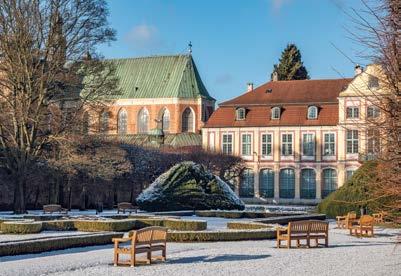
Malczewski), plus French artists (Georges Braque, Wassily Kandinsky, Marc Chagall), and over 65 works by local Nobel Prize-winning author and artist Günter Grass. The palace also hosts temporary exhibitions, as well as concerts, readings, symposia and meetings with artists. The museum is open until 9th March 2025 for the exhibition Obrraz/Picturre. | J-3, ul. Cystersów 18. Open 10:00-17:00; closed Mon. Admission 20/12zł. 4
Oliwa Park Palm House
Oliwa Park’s historic Palm House dates back to the 18th century and has always been a key component of the abbey complex and park. Consisting of a unique 24-meter-high glass rotunda and separate orangery, the entire complex was renovated and reopened as recently as spring of 2022. In fact, the structures had previously been remodelled in the 1950s and the date palm tree
Behind the Abbot's Palace (right) and Oliwa Cathedral (right, p.72). Photo by Jarek Fethke / AdobeStock.
inside had grown so much in the intervening decades that it had damaged the roof of the 15m-tall glass enclosure. In 2017, the old building was dismantled, but the new construction soon became so expensive and problematic that it dragged on for five years, during which time Oliwa’s 180-year-old, 17-meter-tall prize palm tree tragically died and had to be removed. Although the new rotunda is quite spectacular and the historic palm has been replaced by three new ones, a void remains. J-3, ul. Opata Jacka Rybińskiego. Open 10:00-18:00; closed Mon. Admission free.
Beech Avenue & The Prince’s View
Charming 'Beech Avenue' (Aleja Bukowa) is the result of beech trees that were bound in curved frames. Remarkably, the trees have remained in this shape since the frames were removed centuries ago, creating a tunnel effect. Running parallel to the pathway is another ornamental canal. In the past, it was possible to see the Bay of Gdańsk from this vantage point, and both bodies of water actually connected in an optical illusion known as 'The Prince’s View' (Książęcy Widok). Sadly this once-famous view is obstructed today. | J-3.
Japanese Garden
After passing through a section of Oliwa’s botanic gardens, the pathway reveals one of the newer parts of the park grounds - a Japanese-style garden that welcomes you with a torii archway, several other oriental structures and plants, and a gorgeous pond, all of which create the peaceful atmosphere that the ‘Land of the Rising Sun’ is known for. | J-4.
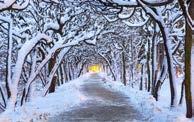

Pachołek Hill Viewing Tower
If you want a bird’s-eye view of the scenery or distant city lights, make your way on foot to this hilltop observation tower in the middle of the woods midway between Oliwa Park and the Zoo. Sitting 100m above sea level, this 15m steel tower has a large platform at the top that puts you over the treeline for great panoramic views of the entire Tri-city. Well worth a look, it’s only about a 10min walk from Oliwa Cathedral, but it will certainly give you some exercise.
J-1, ul. Tatrzańska. Admission free.
Gdańsk Zoo
Scenically set in the forests of Oliwa, 2km from Park Oliwski, this is one of Poland’s best zoos. Open yearround, it is quite possible to spend most of the day here as the 125ha park makes for a pleasant and quite exhausting walk, and there are some additional attractions, including a ropes park (closed in winter) and petting zoo. To get there take bus 169 from the southwest corner of the park ('Cystersów') 2 stops to the front gates. Visiting time: 3.5hrs.
ul. Karwieńska 3. Open 09:00-15:00; from March until 17:00 on weekends; from April 09:00-17:00/19:00 weekends. Last entrance 1hr before closing. Admission 20/15zł, family ticket (2+2) 55zł, kids under 3 free; from April 30/25zł, family ticket 90zł, kids under 3 free.
Tunnel vision on Beech Avenue
Oliwa Park Waterfall
Designed to resemble an open sluice, the wondrous gushing of this man-made water feature below one of Oliwa Park’s many quaint bridges is another favourite spot of social media content creators, wedding photographers and other hopeless romantics looking for the perfect backdrop. | J-3.
Ethnographic Museum
Located within the 18thcentury Abbots' Granary, this charming museum showcases folk artefacts related to the basic activities of various ethnic groups inhabiting Eastern Pomerania in the 19th century, and is considered one of the best collections in Poland. Across three floors, the exhibits include traditional handmade farming and fishing tools, furniture, wood carvings, paintings and more. Visiting time: 1hr.
J-3, ul. Cystersów 19. Open 10:00-17:00; closed Mon. Admission 15/8zł, Fri free.
Oliwa Cathedral
Taking pride of place at the western end of the park, Oliwa’s towering cathedral was originally built in the 12th century, and was burned down twice - once by a negligent kitchen boy in 1350, once during the Swedish invasion of 1626. The latter incident saw many valuables looted, as well as the kidnapping of resident monks! Years later, the cathedral would host the final peace negotiations between Poland and Sweden in 1660. The strangely beautiful interior is dominated by the extraordinary organ over the main entrance. Built between 1755 and 1780, it was once the largest organ of its kind in Europe, and features moving cherubs, fanfaring angels and a staggering 7,896 pipes covering 110 registers, allowing for an incredible range of pitch and sounds including rippling water, animal cries and human voices. Hear it for yourself during one of their frequent organ recitals - for times and prices, visit archikatedraoliwa.pl.
J-2, ul. Biskupa Edmunda Nowickiego 5. Open 09:0017:00; Sat 09:00-15:00; Sun 14:00-17:30. Admission free unless visiting during an organ recital.
OLIWA
Eat & Drink
Overall, Oliwa tends to be more family focused, with a few finer dining options sprinkled in, whilst bars and clubs are more scarce; visit our website for more options.
Tu Można Marzyć
K-3, Oliwski Ratusz Kultury, ul. Opata Jacka Rybińskiego 25
Known for their wondrous breakfast menu, with an impressive range of sweet and savoury, hot and cold, heavy and light options.
012
Bistro Oliwa
K-5, Aleja Grunwaldzka 501
Ideally-located, this restaurant flaunts an extensive menu, from hot breakfasts to sumptuous lunches, and sweet delicacies from its inhouse partner, Kaiser Patisserie!
1205
Ryż
K-2, Stary Rynek Oliwski 2
Oliwa's exceptional resident Thai restaurant, serving generous portions of in an attractive and bright space.
25
Arco by Paco Pérez
Aleja Grunwaldzka 472A
A high-quality restaurant on the 33rd floor of Olivia Star, run by world-famous chef and holder of 5 Michelin stars Paco Pérez.
654


Sopot
Poland’s most famous seaside resort, Sopot grew from a small bathhouse in 1823, into the 'Baltic Monte Carlo' by the early 1900s. Damaged in WWII, the city took on a more bohemian vibe during the communist era, that today infuses its epic nightlife. If you want a beach town with lots of buzz, Sopot is for you.
Sopot coastline and pier. Photo by Aleksander Głowacki, @alexsnapscolours.
Walking Tour
This 2km walking tour takes you from Sopot train station, through its bustling historic centre, down to the pier - a route you could easily do without a map by just following the crowds. It’s not an ambitious itinerary, because that’s not what Sopot is about; most come here for the beach and the bars. That said, do take time to explore the town’s sidestreets and extended beachfront to discover more of its true character and hidden gems.
Garrison Church of St. George
Built at the turn of the 19th/20th century, this modest neo-Gothic church was originally Evangelist, but has been Roman Catholic ever since Sopot’s 1945 re-incorporation into Poland. A neo-Gothic chapel stands outside on the former site of a well on what was once Sopots' market square. Inside the chapel you'll see a rather forlorn-looking statue of St. Adalbert - a Czech missionary who was martyred in 997 after trying to convert the pagan population of nearby Elbląg. His name was later attributed to the 'miracle' of Sopot's natural bromide springs (see #5). M-6, Plac Konstytucji 3 Maja. Open 08:00-17:15; Sun 08:00-19:15.
Train Station
Wojtek, the Soldier Bear
Let’s ‘paws’ near the top of ul. Monte Cassino to learn why Sopot’s famous high street has an Italian name and bronze bear sculpture. First off, ul. Bohaterów Monte Cassino (‘The Heroes of Monte Cassino Street’ or Monciak as it’s known by locals), commemorates the 2nd Polish Corps who fought in the Italian campaign of WWII, specifically those who broke the German line at the Battle of Monte Cassino. Formed by Soviet-exiled Poles in Iran in 1942, the 2nd Corps famously adopted an orphaned bear cub, named him 'Wojtek' and treated
Crooked House
Opened in 2004, this eye-catchingly kitsch, but award-winning building by Polish architecture firm Szotyńscy & Zaleski was inspired by the art of Polish illustrator Jan Marcin Szancer (1902-1973) and Swedish-artist-turned-Sopot-resident Per Dahlberg. The most photographed building in Sopot, the underwhelming interiors host numerous shops, restaurants, bars and clubs (plus a wall of fame with the signatures of celebrities you've never heard of), leading to plenty of crooked-leaning folks after dark.
O-6, ul. Haffnera 6.
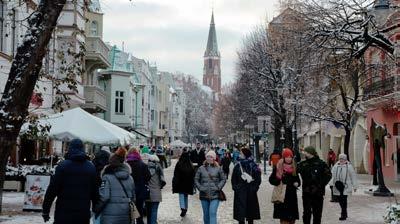
him as one of their own. The bear was given his own rations, including cigarettes and beer - both of which he grew fond of. Unbelievably, Wojtek was actually enlisted in the unit, trained to move crates of ammunition, served in the Battle of Monte Cassino and was even promoted to corporal! After the war he lived out his days in the Edinburgh Zoo until 1963. This statue was unveiled in 2019. Scan the QR code to learn more about this fuzzy hero.
M-6, ul. Bohaterów Monte Cassino.
4
State Art Gallery
Bolstering its perhaps overlooked reputation as an artsy city, Sopot boasts one of the best art galleries in the country. This modern 1200m2 space realises a range of high-quality temporary exhibits from contemporary to traditional, from painting to performance art, from Poland and abroad. Drop in to see what’s on display on your way down to the pier. Next door is a handy tourist information office.
N-6, Plac Zdrojowy 2. Open 10:00-17:00; Thurs 10:00-18:00; closed Mon. Admission 15/10zł, Wed free.
Cruising down 'Monciak' - Sopot's always happening pedestrian high street.
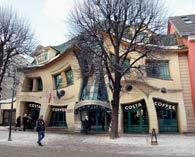
the Rest, we'll take care of the rest.
Inhalation Mushrooms
When French army physician Jean Georg Haffner - who built Sopot’s first spa house in 1823 - heard rumours of the healing waters of Sopot’s St. Adalbert spring, the savvy locals were apparently keyed in on the ground water’s high level of bromide and iodine, in addition to magnesium potassium and potassium iodine. Bathing in such water is recommended for those suffering from arthritis or rheumatism, and a further-diluted variation of the spring can be drunk to help gastrointestinal issues. These glass-domed ‘inhalation mushrooms’ release the water as a mist and breathing in the iodine-filled air is recommended for a whole host of respiratory complaints. You can taste the water by popping into the café on the third floor of the Sopot Tourism Association’s point in The Spa House (see #9).
N-6, Plac Zdrojowy.
5 6
South Park
When Monsieur Haffner started developing the Grand Spa complex in 1823, he wanted to ensure that his guests had somewhere peaceful to lounge about. Thus, the South Park and, later, the North Park (1km north of here), were created. In the 1990s, the South Park was renovated to give it the feeling of its 1920s ‘golden-era’. After the Smoleńsk Air Disaster in 2010, which claimed 96 lives, including thenPresident Lech Kaczyński and his wife Maria, the park was renamed in their honour.
N/O-7, ul. Piastów 5.

Guests a year of Guests satisfied years on the market apartments in the best locations of the Tri-City
Sopot’s iconic Crooked House (‘Krzywy Domek’).
Old Lighthouse
Built as part of a grand spa complex at the very beginning of the 20th century, the design of Sopot’s lighthouse is rather ingenious, in that the structure’s primary function was that of a chimney for the boiler that heated the spa waters. The architect came up with the idea of disguising the chimney by constructing a viewing tower and lighthouse around it. A stone spiral staircase takes you up 135 steps to the 25m viewing platform, providing a wonderful 360-degree view of the coast, pier and the rooftops of Sopot.
N-6, Plac Zdrojowy 3. Open 10:00-18:00 (Jan-Feb 11:0016:00). Admission 10/8zł.
Sopot Pier
Providing great views and crisp Baltic breezes, Sopot's iconic pier ('molo') was first built in 1827 and has been renovated and extended several times since, most recently in 2011. At 511m, it’s the longest wooden pier in Europe (only England's Southend-on-Sea pier is longer, but that's not Europe, right?). Sopot's defining symbol, and the site of frequent events (even an outdoor cinema in summer), at the end of the pier is a marina, restaurant and raised viewing platform.
O-6, Open 24hrs. Admission free.
The Spa House
For 200 years Sopot has attracted visitors from all over the world with its rejuvenating spas and health resorts. The heart of Sopot’s spa district is the historic Spa House with its wonderful rotunda overlooking the fountain, gardens and pier. The first spa house was built here in 1824; by the early 20th century it included ballrooms, restaurants, a hotel and a casino. The current incarnation, from 2009, is the fourth spa house, and includes the State Art Gallery (#4), a tourist info office, restaurants, cafes and, of course, a spa.
N-6, Powstańców Warszawy 2.
The Grand Hotel
Formerly the 'Kasino Hotel,' this indeed grand building is one of Sopot's defining landmarks. Opened in 1927, it was dubbed the ‘Monaco of the Baltic’ and began attracting the rich and famous, with a historic guest list that includes Marlene Dietrich, Greta Garbo, Fidel Castro, Adolf Hitler, Vladimir Putin, The Shah of Iran and Charles de Gaulle. Today a part of the Sofitel group, the hotel still retains much of its classic interwar design. If you're not a guest you can get a look at the interiors by having a meal at the hotel's Art Deco Restaurant.
O-6, ul. Powstańców Warszawy 12/14.

Sopot pier (molo) - the longest wooden seaplank in Europe!

Sopot Fort
The oldest living museum in the Tri-city, built on the site of a fortified hilltop settlement believed to have been used between the 8th and 14th century. Today a branch of the Archaeological Museum, a visit involves two parts: the new indoor exhibition hall, and the medieval outdoor settlement. reconstructed as an exact replica of what once stood here. Consisting of thatched roof wooden huts, live goats (which kids can feed) and reenactors in period costume, this one is best with kids when the weather is nice and workshops are taking place. Therefore, in the colder months, don't expect too much to be on! Nearest station: Sopot Kamienny Potok. Visiting time: 90mins.
ul. Haffnera 63. Open 10:00-16:00; closed Mon. Admission 15/12zł; Tue free.
Forest Opera
A wonderful open-air arena set in a hollow of the forest, this 4400-seat performance venue has existed since 1909, rising to international fame with the Sopot Song Festival - the Soviet Bloc’s answer to the Eurovision Song Contest - from 1964 onwards. Even when there isn’t a performance, this legendary venue is open for visitors who want to tour the grounds and exhibits. If not, it’s a good starting point for a number of hikes, one of which leads to a splendid viewpoint overlooking the bay. You’ll find it a 10-15min walk uphill east of Sopot Station.
ul. Moniuszki 12, www. bart.sopot.pl. Open 10:00-18:00. Admission free.




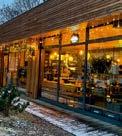

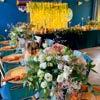

SOPOT
Eat & Drink
Recognised as the region’s party capital, clubbers will have all they can handle in Sopot, while those who look past the main street will find alternative bars and pubs with a devoted local following. When it comes to dining the choice is vast and caters to all budgets, from beachside taverns to Gatsby glamour. Visit IYP online for more recommendations.
COFFEE & BREAKFAST
La Bagatela
M-7,ul. Dworcowa 5, Found within the main train station, we love this spot for its freshly-baked bread, aromatic pastries, tarts, and croissants … oh, and coffee!
02
LAS
N-5, ul. Haffnera 42
Designed by an artist and run by a dietitian and world-champion coffee roaster, there’s no hipper place or healthier way to kickstart your day in Sopot.
02
Piaskownica
ul. Powstańców Warszawy 88
A 15min walk north of central Sopot, reward yourself with either a scrumptious breakfast (or something more Polish) at this charming beachside location.
01284
CASUAL DINING
CRUDO - Steak, Wine & Seafood
N-6, ul. Bohaterów Monte Cassino 63
The name says it all - an extremely-smart space, ideal for making an impression or self-indulgence!
2854
M15
ul. Mamuszki 15
A beach-side restaurant, specialising in fresh, locallyhooked fish and regional cuisine. They also offer pizza, pasta and burgers, and the beach playground is great for kids.
1254
Vinissimo Restaurant & Wine Bar
N-6, ul. Józefa Bema 6
Recently awarded the Bib Gourmand from Michelin, Vinissimo combines a 400-strong wine selection with minimalist dishes for sharing.
25
Masala Kitchen
N-6, Plac Zdrojowy 1
A local long-stay that matches Sopot's vibrancy with authentic Indian curries, tandoori grills, mouth-watering vegetarian dishes, and much more!
254
Adam Gessler Sopot
N-6, ul. Bohaterów Monte Cassino 60
Created by Poland’s celebrity gastro family, the Gesslers, here you can enjoy Polish cuisine that you’ve seen whipped up in the open cooking area.
285
FINE DINING
Diuna
O-4, Aleja Franciszka Mamuszki 22
This beachfront haven allows you to experience the unique flavours of regional dishes, complemented by seabreeze and the murmur of the wavy Baltic!
64
White Marlin
O-7, Al. Wojska Polskiego 1
A fine seafood restaurant leaning towards the smart-casual, with awesome boathouse decór and a killer view of the beachfront.
685
BARS
Avangarda
M-7, ul. Dworcowa 7
A centrally-located bar with a great selection of beer, spirits and cocktails, plus snacks and occasional live music. No pretensions and always a good time.
843
Coctail Bar Max & Dom Whisky
N-6, ul. Jana Kilińskiego 7E
This premium beachside spirits bar is stacked to the roof with endless cocktail mixers and 700 different whiskies.
12583
No.5
M-6, ul. Bohaterów Monte Cassino 5/U2
Easy-going contemporary bar at the very top of Monciak, with American-style pub food and the largest selection of craft beer in the Tri-city.
283
Teatr BOTO
N-6, ul. Bohaterów Monte
Cassino 54B
Exuding Sopot’s old school artistic and independent vibe, BOTO allows you to kick back with a beer and enjoy their fantastic live music roster.
8473
LATE NIGHT
3 Siostry
N-6, ul. Powstańców Warszawy 6
Run by 3 sisters, this is the best club in the Crooked House on Monciak, and is famous for its homemade strawberryflavoured tincture.
847
Carnivale
M-7, ul. Kościuszki 16/4
Hidden behind the main station, Carnivale is something of a best-kept secret when it comes to Sopot’s nightlife. The staff are cool, the beats are hard and the good times roll.
8473
Koliba
ul. Powstańców Warszawy 90
A place you would expect to find in Poland’s mountainous south, this traditional hunting lodge on the beach is a restaurant by day, and a riotous nightclub after dark!
02847
SPATiF
N-6, ul. Bohaterów Monte
Cassino 54
One of the enduring legends of Sopot, SPATiF’s eclectic and avant-garde interior hosts live music and all-night club events with a strict door policy.
473
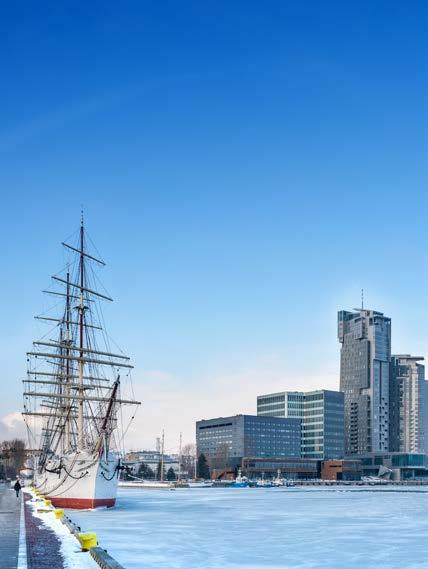
Gdynia
A small fishing village at the end of WWI, Gdynia developed rapidly as a rival port to the Free City of Gdańsk during the interwar years, when it found itself at the end of the ‘Polish Corridor’ - a thin strip of territory giving the new Polish Republic sea access. Although often overlooked by tourists, Gdynia offers unique modernist architecture, top cultural attractions and plenty of beachfront to entice visitors.
view of the ‘Dar Pomorza’ museum ship and Sea Towers complex on Gdynia’s waterfront.
Gdynia Główna Bus Station
Gdynia Główna Train Station
L ĄSKA Warszawsk a
Bydgoska
Ś L ĄSKA
ąl s k a B i ła o s to c ka Pod olsk a B ia łos toc ka
Pol e s k a Batorego
Jana z Kolna Armii Krajowej Zgoda
Gdynia Wzgórze Św. Maksym.
HILL
Walking Tour
Beginning at Gdynia’s main train station, this 5km walking route takes you down to the waterfront via key points of interest in the city centre, with an opportunity to catch public transit to the excellent Emigration Museum. Along the way you’ll learn a bit about Gdynia’s short but dynamic history.
Displaced Gdynians Monument
Starowiejska (Old Village Street) was the main street of Gdynia until ul. Świętojanska was developed in the 1930s. It is here that you’ll find a particularly emotive monument in memory of Gdynians who were deported from the city following the Nazi takeover in 1939. Estimates range from 120,000 to 170,000 people from the Tri-city area, including an estimated 30,000 who were interred or sent as forced labour elsewhere in the Reich. As part of the Nazi’s policy of ‘Germanisation,’ Gdynia was renamed Gotenhafen (literally ‘Goth Port’), referencing the ancient East Germanic tribe of Goths that once inhabited the area. The city’s population in 1939 was about 127,000. By the end of the war, that number had dropped to 70,000. These sculptures, depicting a refugee family forced to abandon their dog as they walk in the direction of the railway station, were designed by Paweł Sasin and Adam Dziejowski and unveiled in 2014.
P-3, Plac Gdynian Wysiedlonych.
Gdynia Market Hall
Gdynia is very proud of its modernist architecture, including this 'pearl' from the 1930s. Today the voluminous indoor market is one of the few places where you can have the post-communist shopping experience of yesteryear, before the arrival of the modern shopping malls and hypermarkets now so familiar across the region. Inside, peruse dozens of stalls offering everything from produce and seafood to clothing and electronics.
P-3, ul. Wójta Radtkiego 36-40. Open 08:00-18:00; Sat 08:00-15:00; closed Sun.
Choose Your Adventure!
Carry on along the prescribed walking route towards Gdynia’s waterfront?
Catch bus 133 from behind the market hall (ul. Jana z Kolna) to the Emigration Museum ('Dworzec Morski - Muzeum Emigracji' stop)?
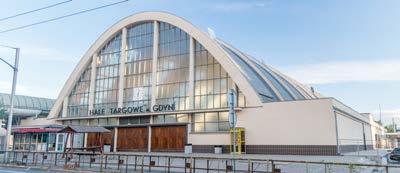
Gdynia Market Hall: the heights of local interwar architecture; photo by Robson90, Adobe Stock.

Emigration Museum
Opened in 2015, this is a fascinating look at how, why and to where millions of Poles have emigrated over the centuries. With Poland thought to have the sixth-largest diaspora in the world, numbering around 20 million, the museum does an excellent job of explaining the various situations, political and economic, which have made people consistently leave Poland to places like the USA, Australia and even Brazil. The museum is appropriately located in the former Dworzec Morski (Marine Station), which was the departure point for many Polish emigrants in the interwar years. A visit is highly recommended, especially for those with Polish roots.
To get to the museum, take bus number 119 (Mon-Fri only) or 133 (check that the destination is 'Dworzec Morski - Emigration Museum') from Gdynia Główna train station (the bus stop is actually on ul. Jana z Kolna). Alternatively, a taxi will cost about 20zł or you can walk there in about 20mins from the city centre. Visiting time: 2hrs.
R1, ul. Polska 1. Open 10:00-18:00; Tue 12:00-20:00; closed Mon. Last entrance 1hr before closing.
Admission 19/15zł, kids under 7 free; Wed free.


Antoni Abraham Monument
Turning left onto Gdynia’s main street, ul. Swiętojańska, and heading north will eventually bring you to a larger-than-life statue of Antoni Abraham. Born in 1869 in Zdrada, 25km north of Gdynia, Antoni was a Kashubian activist who campaigned for the incorporation of Kashubia into the newly-formed Polish state after WWI. His bitterness towards German rule was compounded when he, his two sons and his son-in-law were conscripted into the Kaiser’s army in 1915. While in combat, all three younger men were killed in front of him, while Abraham himself was seriously wounded. Abraham attended the Paris Peace Conference of 1919, where the map of Europe was redrawn following Germany’s WWI defeat, and the significant Kashubian delegation that supported Poland was crucial to large parts of Kashubia becoming Polish territory in 1920. This statue was unveiled in 2001 with the inscription ‘Syna Ziemi Kaszubskiej –Bojownika O Jej Polskość’ (Son of the Kashubian Land - Fighter for its Polishness). The yellow and black flag you see raised around the square is the flag of Kashubia.
Q-3, Plac Kaszubski.
ORP ‘Błyskawica’ Warship
Known in Poland as ‘The Warship of the Polish Republic’, Błyskawica (Lightning) was one of the fastest destroyers in the world when it launched in 1936. Following the invasion of Poland by Nazi Germany, the ship and her crew were placed under the command of the British Navy. Her best-known engagement was in 1942 off the coast of the British Isle of Wight, when she successfully defended the town of Cowes from a Luftwaffe attack. While the ship’s captain and crew had correctly anticipated the attack and were armed and ready to fire back, this was actually in contravention to direct orders from the British Admiralty, and their heroism wouldn’t be publicly acknowledged until 2004. Błyskawica was retired from service in 1969 and has since served as a museum ship (Closed from November til March), held in the sort of regard that the UK has reserved for the HMS Victory. It’s also the only ship to be awarded Poland’s highest military decoration, the Gold Cross of the Virtuti Militari Order. Viewing time: 1 hour.
R-3, Aleja Jana Pawła II. Open 10:00-13:00, 14:00-18:00; closed Mon. Last entrance 45 mins before closing. Admission 30/19zł.
Although closed in winter, this WWII-era warship is still a highlight of the Leisure Pier.
‘Dar Pomorza’ Museum Ship
One of the most well-travelled ships in Poland, this three-masted training vessel has visited 383 ports and clocked more than 800,000km in her time at sea. She began life as Prinzess Eitel Friedrich, constructed in 1909 in Hamburg to train cadets for the German navy, however, in 1920, the British commandeered her as part of post-WWI reparations. She was later given to the French Naval School in St. Nazaire and renamed Colbert. It was then passed on to the French-born Baron Maurice de Forest, who sold it for £7,000 to the Polish Naval Academy in Gdynia in 1929. Now Dar Pomorza (The Gift of Pomerania) it continued to be used as a training ship and has taken part in numerous sailing competitions, famously winning the Cutty Shark Trophy in 1980. After she was bestowed with the Order of Polonia Restituta, the highest decoration of the Polish State, she became part of the collection of National Maritime Museum in Gdańsk in 1983. On board you'll see original artefacts and the living and working conditions of the Polish crew. This museum ship is closed until February. Viewing time: 30mins.
R-3, Al. Jana Pawła II (Nabrzeże Pomorskie). Open 09:00-16:00, Mon closed. Admission 30/19zł, kids under 7 free.
Joseph Conrad Monument
A name well-recognised in English literature, many people don’t know that Joseph Conrad was actually born Józef Teodor Konrad Korzeniowski (1857-1924), who hailed from Berdychiv (now Ukraine) and was a merchantmarine for almost 20 years before first being published. Notable works include The Secret Agent and Heart Of Darkness, the latter of which inspired the 1971 film Apocalypse Now. Conrad had no known connections with Gdynia and this sculpture simply lays claim to his Polish nationality and the influence that his sea-faring years had on his works. The inscription, taken from his novel Lord Jim, reads: “Nic tak nie nęci, nie rozczarowuje i nie zniewala, jak życie na morzu” (There is nothing more enticing, disenchanting, and enslaving than life at sea).
S-4, Al. Jana Pawła II 1.
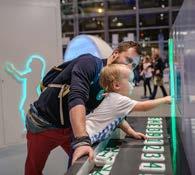
Centrum Nauki Experyment
An excellent family 'edutainment' option, the 'Science Experiment Centre' (as it roughly translates) is the showpiece of the Pomeranian Science & Technology Park, one of Gdynia's proudest investments. Set inside a modern glass building, the interactive interior displays are classified into one of five thematic categories: Hydroworld, Operation Human, The Tree of Life, Invisible Forces and Towards Health. Visitors are encouraged to experiment freely and learn about different phenomena in our everyday lives by pushing, pulling and jumping on the exhibits, rather than simply looking at them. Thanks to English and Russian translations, most foreign guests can gain a full understanding of each hands-on exhibit. Though set entirely inside one vast, open space, the number of stations and sheer fun of it all will keep kids and parents busy for hours. Restaurants are next door, or pack some food and eat it in the designated area inside. Nearest station: Gdynia Redłowo. Visiting time: 2-3hrs.
Al. Zwycięstwa 96/98. Open 09:00-18:00; Sat, Sun 10:00-19:00; closed Mon. Last entrance 1hr before closing. Admission 30/25zł; family ticket (2+1) 80zł, every next person (child or adult) 20zł.
Gdynia Aquarium
Located in a building from the 1970s, this facility has been gradually modernising its exhibits and, while it may not knock your socks off, it is worth a visit for familes (who may have trouble avoiding it thanks to its Leisure Pier location). Over three floors, the thematically grouped exhibits cover coral reefs, Amazonia, deep waters, the Baltic Sea and more, including some reptiles and amphibians. They also delve into the evolution of submersible technology and current issues relating to the sea environment. All told, it's about 1500 living organisms and a enjoyable place to take the kids without exhausting yourself.
Viewing time: 90mins.
S-4, Al. Jana Pawła II 1. Open 10:00-17:00; Nov-Feb closed Mon. Admission 42/30zł; kids under 5 free.
8
Gdynia City Beach
Gdynia’s city-centre beach outshines its neighbours with modern shower and toilet facilities, a fantastic playground for kids, beach volleyball courts, and numerous bars and restaurants. The views are also great, whether you’re looking at the sea, the city, or its people. With plenty of space, the beach stays packed in the summer months and serves as the city’s natural gravitation point. | R-4.
Choose Your Adventure!
Head east to the Stone Hill funicular (#11) for great views over the city and seacoast?
Stay grounded and stroll south along Bulwar Nadmorski (#12) towards Gdynia Redłowa?
9
Gdynia Naval Museum
Like toys on a messy bedroom floor, the grounds of this open-air maritime museum boast a gigantic collection of guns, cannons, fighter planes and other paraphernalia that constitute the main part of the collection. Meanwhile, inside you’ll more bombs and artillery, as well as some very impressive wooden models of famous ships on the upper floor. Viewing time: 1hr.
R-4, ul. Zawiszy Czarnego 1B. Open 10:00-16:00; closed Mon. Admission 30/19zł; Sun free.

Gdynia Orłowo
Directly two train stops between Gdynia (to the north) and Sopot (to the south) lies Gdynia Orłowo - arguably the Tri-city's most scenic piece of coastline. A walk from the station to the sea only takes 15mins; along the way you'll pass some of the interbellum villas that characterise the area, including the Willa Lubicz hotel, looking like the setting of an Agatha Christie whodunit. Orłowo began to develop just after WWI, when a Polish seaside resort to compete with Sopot was envisioned. A Therapeutic House (today abandoned) and pier were built and stately guesthouses cropped up to accommodate holiday makers. It was during this period that Polish author Stefan Żeromski used the scenic spot as a writer's retreat; the small cottage he lived in is today a museum. WWII halted the resort's development, resulting in the peaceful and charming coastal neighbourhood we have today. The iconic Orłowski Cliff, 180m wooden Orłowski Pier and several old fishing boats on the sand make the area popular with couples and photographers, and there are several decent eateries nearby. If you're up for it, consider hiking the trails north through the nature preserve, and keep your eyes peeled for military bunkers. Nearest station: Gdynia Orłowo.
SPREAD THE GOOD WORD!
Scan the code to see our full range of City Guides, and while you’re there, please leave a review so fellow travellers can hear about your experience.
Your voice matters! Find this guide useful?












SCAN CODE TO CONTINUE
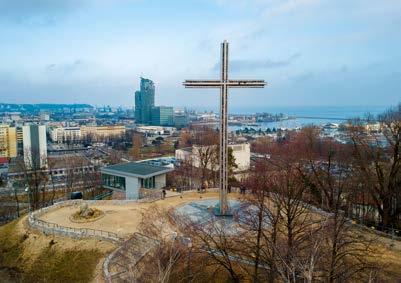
Gdynia City Museum
A modern museum presenting the short but fascinating history of this relatively young city. See photography collections of early Gdynia, watch the accounts of people who lived through both German and Russian occupations, listen to local music of the communist era and read accounts from an incredibly diverse population that lived here in the early 20th century. Viewing time: 1hr.
R-4, ul. Zawiszy Czarnego 1. Open 10:00-16:00; Wed 10:0018:00; Sat, Sun 10:00-17:00; closed Mon. Admission 20/12zł; kids under 7 free; Tue free.
Stone Hill Funicular
A great view of the Hel peninsula and the Baltic Sea awaits you at the top of Kamienna Góra, a stoney hill in the heart of the city. Use the free modern glass gondola to get you up, or burn more calories on the nearby stairs. From the City Museum, head along ul. Franciszka Sędzickiego and follow the path
behind the Theatre building. The gondola is next to the entrance of the Outdoor Music Shell in the park.
Q-4, Plac Grunwaldzki 1. Open 10:00-20:00. Admission free.
Bulwar Nadmorski
A favourite place of locals out for a stroll and taking in the Baltic seabreeze, Bulwar Nadmorski (Seaside Boulevard) is more than just a pedestrian strip. If you look over the seaside edge, you can see the curved base, which acts as a breakwater against big waves eroding the coastline. Baltic weather is known for its severity, and the first concrete path, built in the 1930s, was actually destroyed in a huge storm in 1949. So far, the current version, dating from 1969, continues to withstand nature’s worst! While it truly shines in summer, it's not totally dead in the off months. In winter, you'll find mobile cafes and the occasional busker braving the elements!
R-5, Bulwar Nadmorski im. Feliksa Nowowiejskiego.
The massive steel cross atop Stone Hill.
GDYNIA Eat & Drink
Believe it or not, the serious sister of the Tri-city family isn’t such a dull place when it comes to gastronomy. Although nightlife isn’t a strong point (that’s Sopot’s domain), here you’ll find an intriguing selection of unique places that Gdynia offers up for its own enjoyment, as opposed to that of the tourist crowd. For more, visit our website.
COFFEE & BREAKFAST
Coffee Shop Happy People
Q-4, ul. Świętojańska 49
Service with a smile! This local baristocracy matc with a menu of loaded bagels, and toasted sandwiches!
02
Kosmos
Q-3, Starowiejska 25
A new cafe venture by one of the Tri-city’s most sought-after baristas, residing in a funky retro shorefront on Gdynia’s oldest street. Coffee lovers, mark this one!
0
CASUAL DINING
HAOS
Q-3 , ul. Starowiejska 14
A marvellously colourful, relaxed and popular restaurant serving a range of Asian dishes from spring rolls to curry and Pad Thai.
25
Oberża 86
Q-3, ul. Starowiejska 30
Officially recommended by Michelin, this cosy restaurant creates a gastronomic fusion of local Kashubian flavours, refined with the elegance of French cuisine.
25
Searcle Gdynia
R-3, ul. Jerzego Waszyngtona 19
The rich and plentiful sea, nearby forests and fields are all key sources of inspiration behind the concept of this restaurant, ideally located on Gdynia’s seafront.
25
FINE DINING
Biały Królik
ul. Folwarczna 2 (Gdynia Orłowo)
Set in a restored manor house in Orłowo, this fine dining affair serves exceptional and imaginative local cuisine in incredibly stylish surroundings.
24
CRUDO - Steak, Wine & Seafood
Q-4, ul. Świętojańska 43
The name says it all - an extremely smart space dealing in the three essentials of fine dining. Great for dates and/or self-indulgence.
6548
NIGHTLIFE
Blues Club
Q-2, ul. Portowa 9
Gdynia’s internationallyrenowned blues bar is the perfect place to knock back a drink and enjoy quality live music from Poland and abroad.
283
Klub Desdemona
Q-4, ul. Abrahama 37
Popular for its intimate concert venue downstairs (a weekend affair), this is the go-to spot for young alternative folk in town.
843

Tri-city Day Trips
Run out of places to explore in the Tri-city? Of course not, but take note that the surrounding region offers an additional wealth of wondrous places worth discovering.


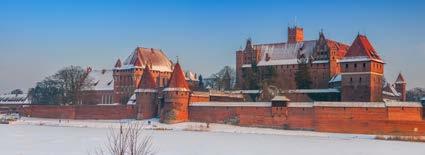
1 Hel
Across the Bay of Gdańsk, the Hel Peninsula is a lot more heavenly than it sounds. This thin strip of land projecting into the Baltic (only 100 metres across at its most narrow point) offers pristine beaches on all sides. At its very tip, the charming village of Hel is home to lovely brick and timber architecture, a colony of seals at its famous Fokarium (Seal Centre), and delicious daily catches of fresh fish - dine out during your visit. Arguably too popular in summer, in winter this sleepy fishing village has a remote maritime vibe and is a great place for anyone seeking seclusion. It is the very end of Poland, after all.
Getting there: Trains make the very scenic ride from Gdynia to Hel in less than 90mins.

2
Łeba & Słowiński National Park
In summer the seaside village of Łeba (about 100km from Gdańsk) is even more hellish than Hel when it comes to crowds and commercial kitsch, but not so in winter. In the offseason, there are still plenty of family attractions and the fishing town even has a quaint charm. It's the jumping off point for Słowiński National Park, which is home to the biggest sands dunes in Europe, backing onto a stunning forest of pines and a unique coastal lake. Pack food and supplies, and escape into the dunes!
Getting there: Take the train to Lębork (6090mins), then catch the bus to Łeba (40mins). If the weather isn't completely arctic, rent a bike when you get there and head west.
3 Malbork
62km south-east of Gdańsk is Malbork Castlethe world's biggest brick fortress, and inscribed on the UNESCO World Heritage List. One of Poland’s most impressive historical sites, this stunning castle complex was built in the 13th-century by the once-dominant Order of Teutonic Knights, and is so big that its incredible architecture, artefacts and exhibits take most of a day to explore. Although almost battered to oblivion during WWII, Malbork Old Town also harbours a few scenic points of interest, including two medieval city gates and the splendid Old Town Hall.
Getting there: Take a train from Gdańsk (1hr) and walk to the castle (15mins).
4 Kashubian Ethnographic Park
Set on a lake in the Kashubian coutryside, Poland's oldest open-air museum is one of the highlights of a road trip around the rural region west of Gdańsk. Learn about Kashubian folk culture as you explore 40 superb structures built between the 18th and early-20th century. English-speaking guides can tell you a bit about their history, and there's also a tavern serving traditional food. Open Mon-Friday.
Getting there: Located in Wdzydze, the drive from Gdańsk takes about 1hr 15mins.
5 Stutthof
The first Nazi death camp built outside of Germany and the last to be liberated, some 110,000 prisoners (the majority Poles and Jews) were held here, with 68,000 perishing inside. Today, a museum and memorial, among the horrific details is evidence of Nazi experiments to produce soap from the body fat of victims. Set within the forest just a few kilometres from the beach, this peaceful and seldom-visited former camp has a different atmosphere than Auschwitz, but an equally lasting effect.
Getting there: Take Bus 870 - marked either ‘Sztutowo’ or ‘Krynica Morska’ - from Gdańsk Bus Station and travel 55km east.
6
Toruń
Idyllically located on a bend of the Vistula River, Toruń is one of Poland’s most treasured historic sites, famous for its Gothic architecture, gingerbread and Copernicus connections.
Toruń’s Old Town, full of medieval brick buildings, cobblestone lanes, gas lanterns and stained glass, exudes an undeniable fairytale magic that has earned its entry onto the UNESCO World Heritage List. Embodying all the charms of the quintessential medieval city you have in your imagination, the joy of Toruń is in wandering around its historical centre and discovering its many stunning architectural monuments. These include the Old Town Hall - replete with a gorgeous collection of Gothic art, precious stained glass windows and a 40m clock tower with an open-air viewing terrace; St. James the Greater Church - a 13th century Gothic masterpiece considered by many to be the most beautiful church in Europe; several soaring city gates and brick towers along the medieval defensive walls, including the Leaning Tower of Toruń; the ruins of the Teutonic Castle; and Philadelphia Boulevard - the city’s riverside promenade.
Toruń also proudly boasts several museums

and monuments connected to famed astronomer Nicolaus Copernicus, who grew up in Toruń before literally turning the universe inside-out with his revolutionary work positing that the Earth rotates around the sun, and not vice versa. The astronomer’s childhood home is not only an excellent interactive
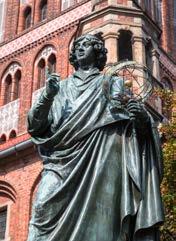
multimedia museum today, but also boasts one of the finest facades you’ll see anywhere. Naturally, the city possesses a state-of-the-art planetarium as well. Toruń is also famous in Central Europe for its heartshaped, chocolatecoated gingerbread, which can be bought all over the city. Alternatively, you can make your own at a workshop in the Museum of Toruń Gingerbread, residing within the building of the oldest gingerbread factory in Europe!
Getting to Toruń: 170km south of Gdańsk, Toruń can easily be done as a day trip, but be advised that the city’s charms tend to inspire longer stays (consider spending the night). Located on the A1 motorway (European No. E75), by car you can get there in 1hr 40mins. Buses (30-40zł) and trains (60zł) both run regularly with similar journey times of 2hrs 20-40mins.
Learn more about all there is to see and do in Toruń!


Print space is limited, but the internet is a vast, vacuous void we’ve devoted our days to filling. If the sightseeing venue you’re looking for isn’t listed here, you’ll likely find it on our website:
Abbot's Palace 69
Amber Museum 47
Antoni Abraham Monument 86
Artus Court 42
Beech Avenue 71
BHP Building 59
Browar Gdańsk i Mural 63
Bulwar Nadmorski 90
Centrum Nauk i Experyment 87
Christmas/Holiday Lights 15
Church of the Sacred Heart of Jesus 66
Crane 50
Crooked House 76
'Dar Pomorza' Museum Ship 87
Displaced Gdynians Monument 84
Emigration Museum 85
Ethnographic Museum 72
European Solidarity Centre (ECS) 59
Fahrenheit Monument 42
Forest Opera 79
Garnizon 66
Garrison Church of St. George 75
Gate #2 of the Gdańsk
Shipyard 59
Gdańsk Market Hall 46
Gdańsk Shakespeare Theatre 41
Gdańsk Shipyard Cranes 61
Gdynia Aquarium 88
Gdynia City Beach 88
Gdynia City Museum
Gdynia Market Hall 84 Gdynia Naval Museum 88
Gate 41 Grand Hotel 78 Grass Family House 66 Grass Grocery 64 Great Armoury 45 Green Bridge 53 Green Gate

